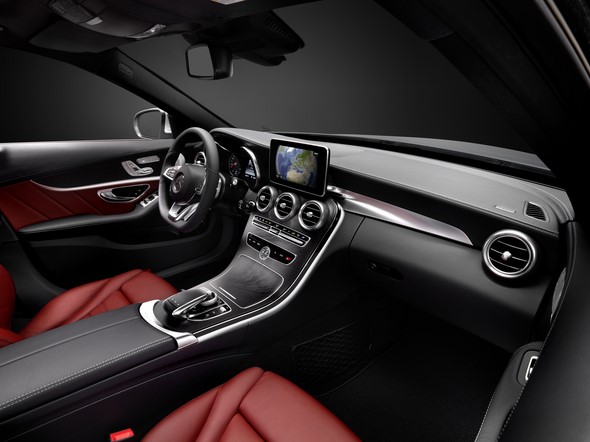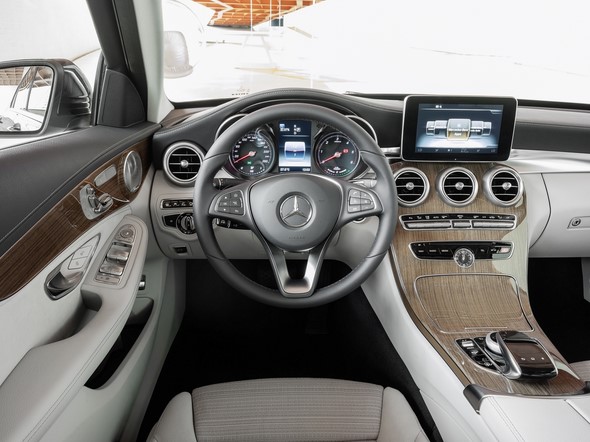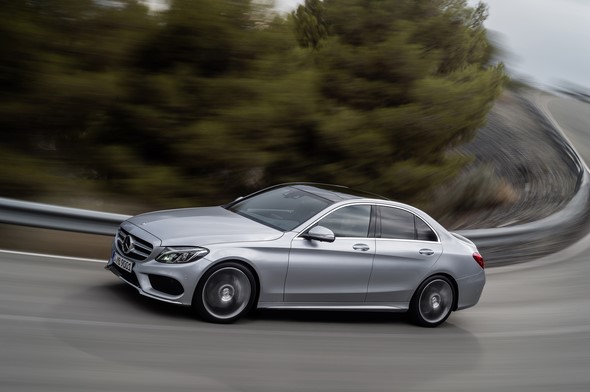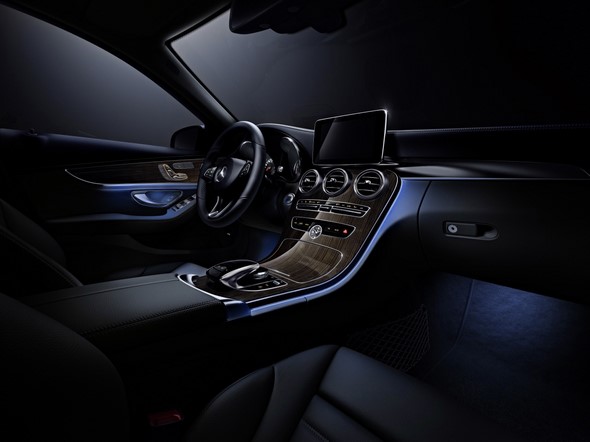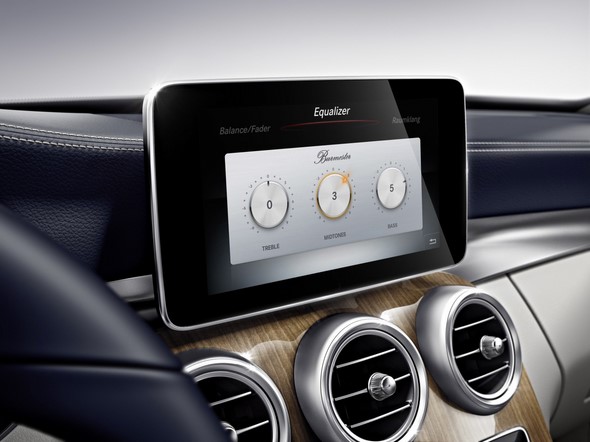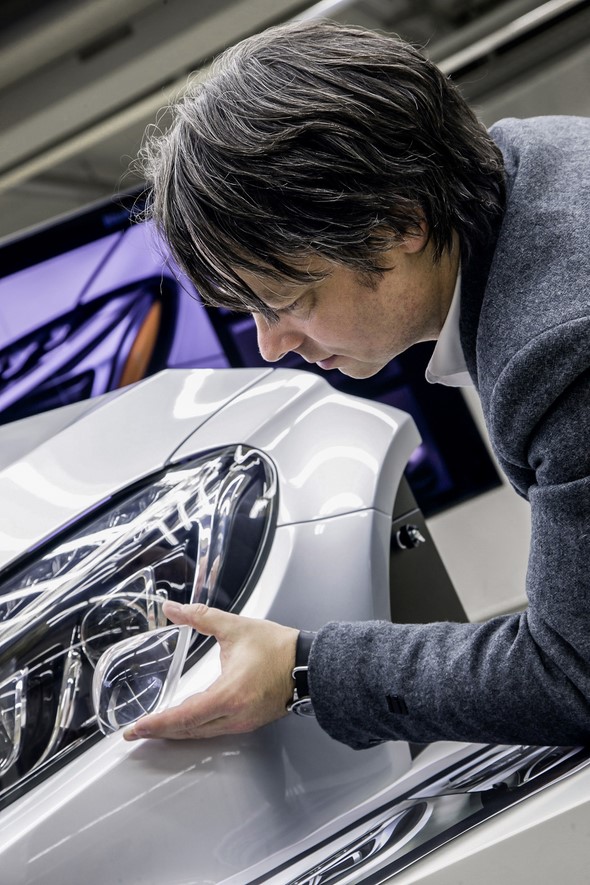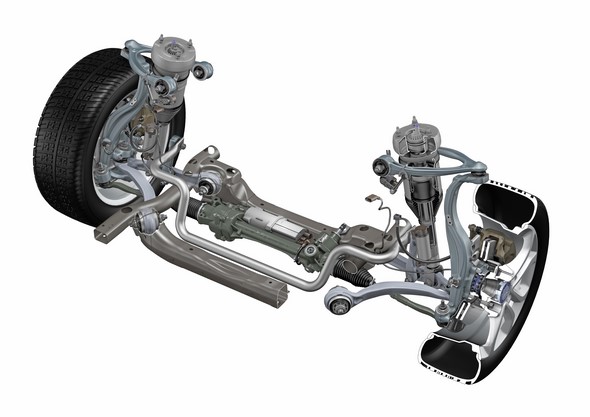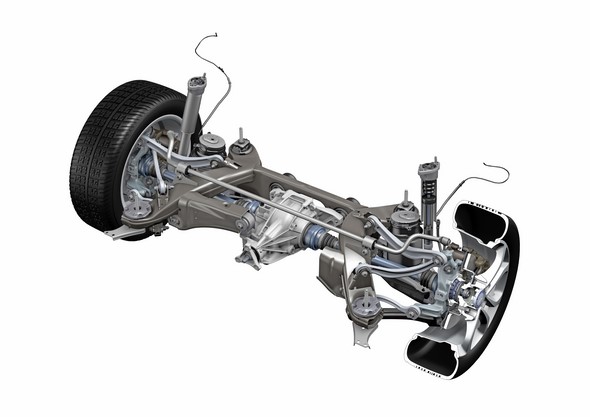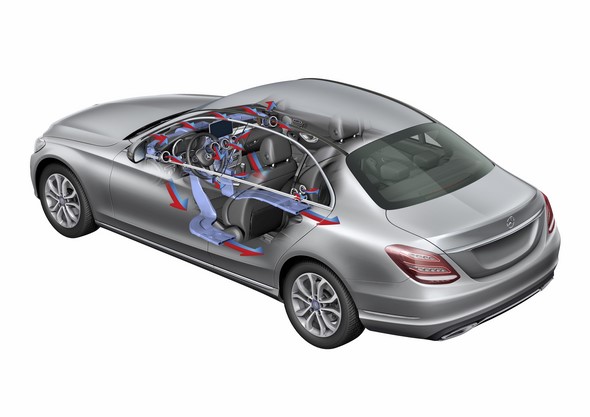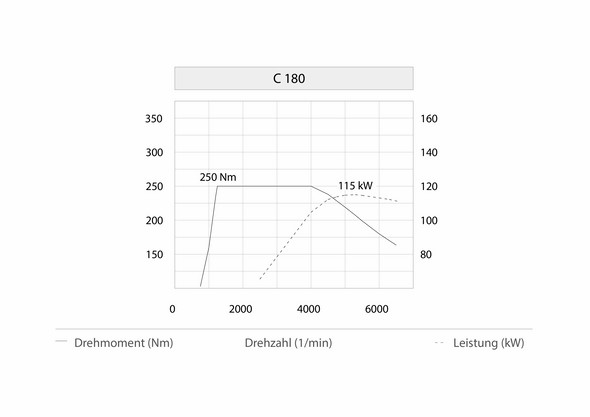The new Mercedes-Benz C-Class

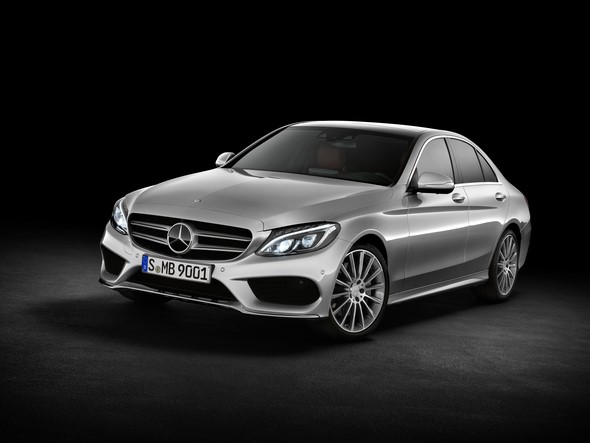
Sheer attraction
The all-new C-Class heralds a new chapter in the Mercedes-Benz success story and sets new standards in the premium medium-size category.
Thanks to an intelligent lightweight-design concept boasting weight savings of up to 100 kilograms, excellent aerodynamics and new economical engines, the C-Class establishes new efficiency benchmarks in its segment.
A host of new assistance systems offers safety of the highest standard, while a new optional air-sprung suspension provides for exemplary ride and driving comfort as well as nimble and agile handling.

In terms of appearance the new C-Class adopts a progressive approach with its clear yet emotional design and its high-class interior.
Many other innovations and equipment features underscore the Saloon’s energising comfort and refined sportiness. In all, the high-class appeal of the new C-Class feels like an “upgrade to a higher class of vehicle”.
The new C-Class offers sensuous and clear design and a host of technical innovations as well as a comprehensive scope of standard equipment and exemplary emissions and fuel consumption figures.
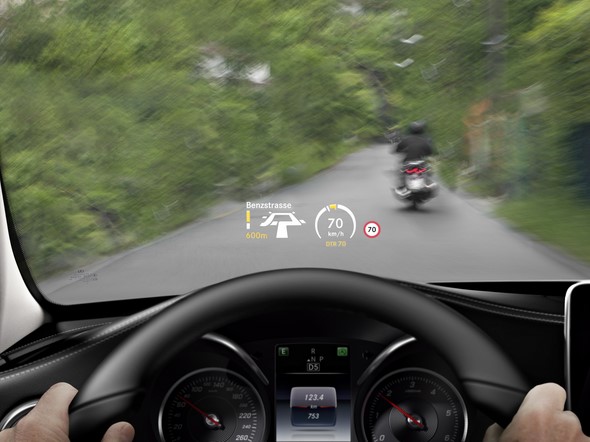
This all adds up to substantial added value and long-term savings on motor vehicle tax and at the filling station.
The C-Class has grown to take account of people’s increasing average height. With an 80-millimetre increase in the wheelbase (2840 millimetres) compared with the previous model, the vehicle is 95 millimetres longer (4686 millimetres) and 40 millimetres wider (1810 millimetres).
The result is a more spacious interior. At 480 litres the new C-Class also surpasses its predecessor in terms of boot capacity (in accordance with ISO 3832).
Sensuous clarity and purist forms
On a visual level, the new C-Class represents a bold departure from its predecessor. Its striking, dynamic design exudes sensuous clarity and arouses emotions.
Modern aesthetics were the source of inspiration for the new Saloon’s sensuous lines and surfaces, whose harmony and dynamism directly touch everyone.
The designers have created minimalist, purist forms for the C-Class which emphasise its intelligent technology and engineering.
The clearly defined surfaces also deliberately display a degree of tension, lending them a modern and at the same time emotional character.
Precise lines and sculptural surfaces create progressive light and shadow effects.
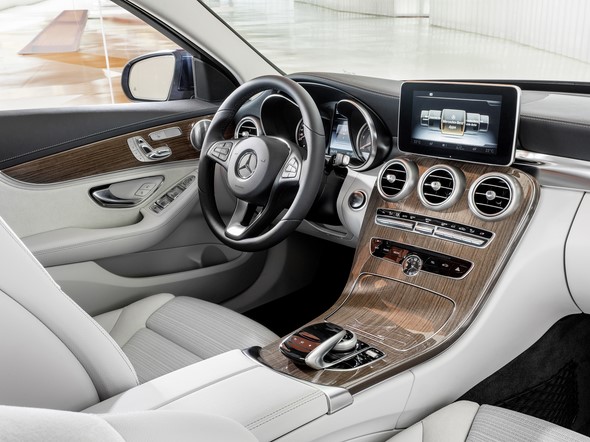
In the side view a long bonnet, a passenger compartment set well back and short overhangs define the C-Class’s classic, well-balanced Mercedes-Benz Saloon proportions.
There is a choice of two different fronts: sporty with a central star or – reserved solely for the EXCLUSIVE line – the classic Saloon radiator grille with the Mercedes star on the bonnet.
This grille can close the louvres completely to optimise the Cd value, and with its overall appearance superbly emphasises the status of the refined Saloon.
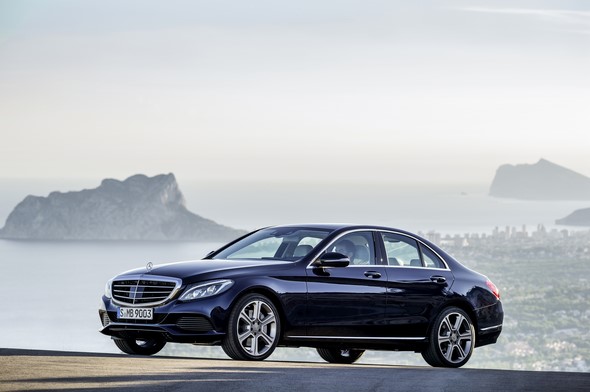
The new C-Class comes with H7 halogen headlamps as standard. In addition to the standard-fit headlamps, two energy-saving LED variants are available: a static system and a dynamic version with the “LED Intelligent Light System”.
The characteristic night design lends the new C-Class its very own distinctive look in the dark, too. The rear lamp and brake light in the tail lamps feature LED technology with all headlamp versions.
High-class interior with fine details
The Mercedes-Benz designers have styled the interior on a level which is rarely encountered even in higher vehicle categories.
This applies to the carefully chosen high-class materials and their pleasant touch and feel as well as to the precision of the finely crafted details.
But also equally to a new design idiom which perfectly combines sensuousness and clarity with dynamic sportiness, and thus contributes to the high-class appeal of the interior.
The driver and front passenger enjoy a great deal of space and luxury in an unobtrusive, modern style on board the new C-Class.
This gives rise to a feel-good atmosphere which is new to this category of vehicle – settling into your seat in the C-Class is akin to the uplifting feeling of being upgraded from economy to business class on an airliner.

The interior design demonstrates a bold new approach by Mercedes-Benz.
Here the designers combine in accomplished style the architecture of the Mercedes-Benz sports cars with a totally new centre console featuring sporty flowing lines.
In vehicles with automatic transmission, a large one-piece centre console panel performs an elegant sweep from the centre air vents to the armrest.
These seamless, clear-cut lines create a sense of open space and convey a thrillingly purist and modern feel.
On vehicles with manual transmission, the centre console is slightly steeper and features two separate trim elements in order to create ample space for ergonomic operation of the shift lever.
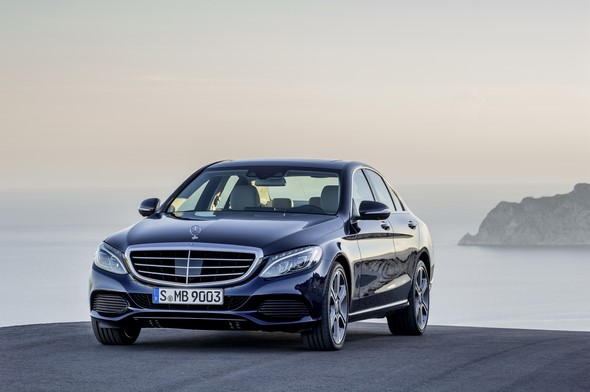
A centrally positioned free-standing central display is the main eye-catching feature across the centre console – with a screen diagonal of 17.78 centimetres (7 inches), or 21.33 centimetres (8.4 inches) if COMAND Online is specified.
Five round air vents lend the instrument panel a sporty touch. With their metallic cool-touch effect they create a tangible contrast to the warm look of the other materials – such as the wood in the centre console or the ARTICO man-made leather on the instrument panel.
The “upgrade” feel duly continues with the controls. All switches have a high-quality, three-dimensional design befitting a luxury vehicle and benefit from a clear layout.
The innovative touchpad developed by Mercedes-Benz in the handrest above the controller on the centre tunnel marks a further evolutionary step. As on a smartphone, this provides for very simple and intuitive operation of all the head-unit functions using finger gestures.
The touchpad also permits letters, numbers and special characters to be entered in handwriting – in any language supported by Audio 20 or COMAND Online.
The user receives clear tactile feedback when operating the touchpad’s control surface, which is highly conducive to genuine intuitive use.
A head-up display is also new to the C-Class. Like in a fighter jet, it displays important information directly in the driver’s field of vision on the front windscreen, thus providing for clear legibility and less distraction from the road ahead.
The system provides information on speed, posted speed limits, navigation instructions and messages from the DISTRONIC system.
Three different design and equipment lines for the exterior and interior each offer further scope for individualisation in addition to the standard equipment and appointments.
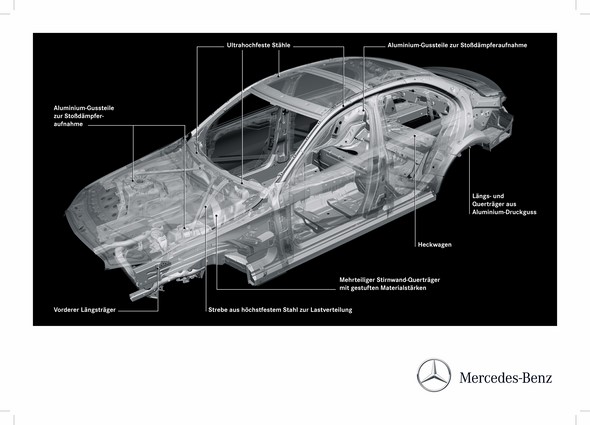
The AVANTGARDE line showcases the C-Class as a sporty Saloon, the EXCLUSIVE line places the emphasis on an elevated status and modern luxury while the AMG Line lends the C-Class a decidedly sporty appearance.
Rigid body – lightly done
The body-in-white of the new C-Class provides an innovative basis for reduced weight, outstanding rigidity, including load introduction rigidity for excellent handling, combined with optimum noise and vibration characteristics and a high level of crash safety.
Thanks to intelligent and innovative lightweight construction, the aluminium hybrid body is around 70 kg lighter than a conventional steel body. The vehicle’s overall weight is even reduced by up to 100 kilograms. As such, the new C-Class leads the “lightweight rankings” in its segment.
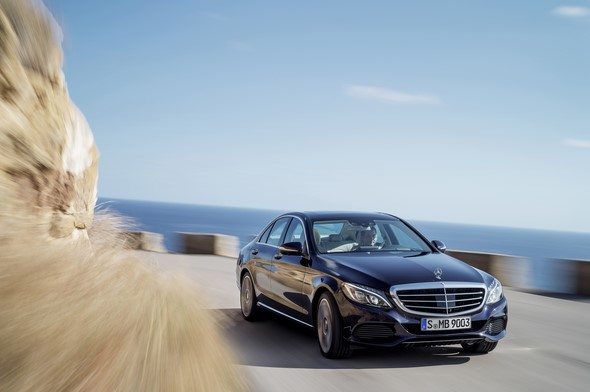
This spawns numerous benefits: the lightweight construction of the new C-Class cuts fuel consumption by up to 20 percent without any loss of performance, while at the same time enabling a lower centre of gravity, which in turn gives rise to the vehicle’s noticeably sporty and agile handling.
Mercedes-Benz achieves this technological leap in lightweight construction by various measures, including a completely new design and an unusually high aluminium content for a vehicle built in large-scale series production.
Compared with the successful predecessor, the aluminium content has increased from less than 10 percent to almost 50 percent.
In keeping with Mercedes-Benz traditions, the body shell is designed for exemplary crash safety.
The Saloon not only meets all current national and international laws, but also all rating requirements as well as the more stringent internal Mercedes-Benz safety requirements, which are based on what actually happens in real-life accidents.
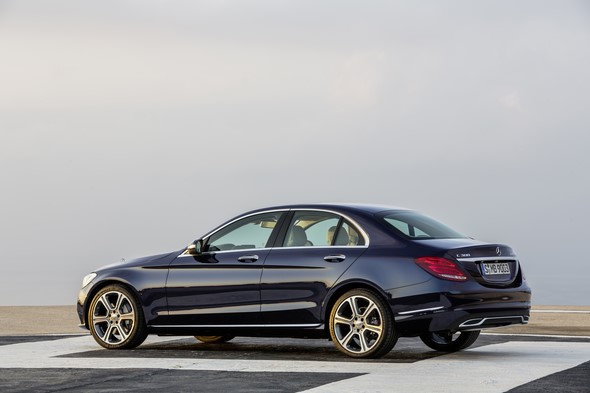
A high-strength passenger safety cell forms the core of this concept. It is surrounded by specifically computed and field-tested deformation zones, which ensure maximum safety for the occupants by virtue of optimised force paths and a combination of die-cast aluminium components and ultra-high-strength materials.
An outer skin consisting almost completely of aluminium provides a protective shell for the body structure.
Leading the field in aerodynamics and quiet running
A low drag is crucial to achieving outstanding efficiency. From a speed of just under 70 km/h, aerodynamic drag exceeds the sum total of all other driving resistance factors.
As such, drag constitutes a major leverage in efforts to reduce fuel consumption and CO2 emissions.
With a Cd value of 0.24 for the C 220 BlueTEC BlueEFFICIENCY Edition, the new C-Class Saloon sets a new benchmark in the medium-size category.
The wind noise level, which was already very low in the preceding generation of the C-Class, has been lowered still further.
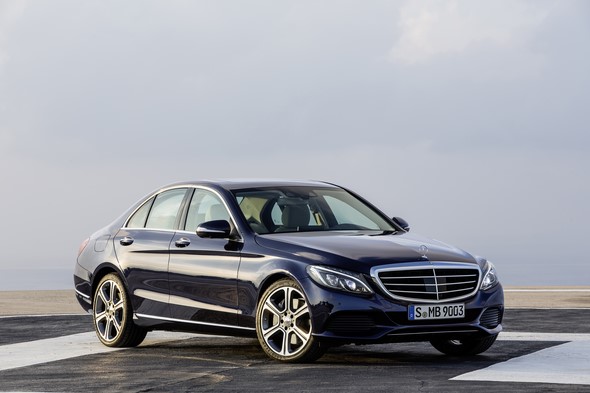
The engineers have also devoted painstaking attention to optimising other potential sources of disturbance that may have an adverse effect on the driver’s and passengers’ well-being and concentration, even though they may not consciously notice their effects.
NVH (noise, vibration, harshness) is the technical term for such nuisance factors. The specialists have optimised the noise characteristics of the interior blower, the power windows, the seat adjustment functions and many other actuating and operating noises, for example.
As a result, the new C-Class occupies a benchmark position in its segment in terms of NVH.
Outstanding CO2 values with new small diesel engine
Powerful and efficient petrol and diesel engines, all equipped with the ECO start/stop function and complying with Euro 6 emissions standards, provide for lively performance and great fun at the wheel.
They also cut fuel consumption by up to 20 percent compared with the preceding model.
An innovation is a small diesel engine with a displacement of 1.6 litres. Reduced weight, compact design and low specific fuel consumption are among its special merits.
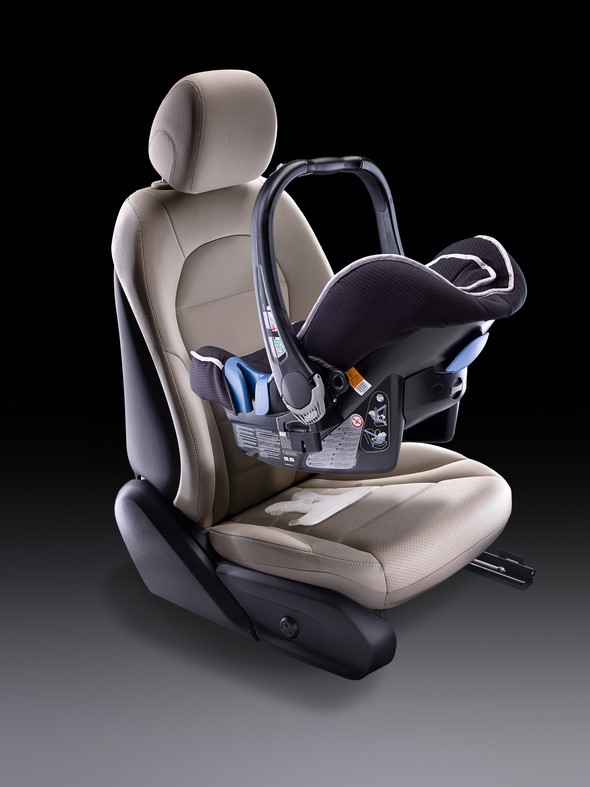
Depending on its configuration, the single-stage turbocharged four-cylinder engine generates 85 or 100 kW (115 or 136 hp) of power from a displacement of 1598 cc and delivers 280 or 320 Nm of torque.
This engine puts the new C-Class in a leading position within its segment in terms of CO2 emissions. Among other things, this was made possible by the first-ever use of steel pistons in a passenger car diesel engine.
In addition to this new small diesel engine, an advanced version of the proven 2.2-litre four-cylinder diesel engine is also available in several output variants.
The diesel engines thus cover an output range from 85 kW (115 hp) to 150 kW (204 hp).
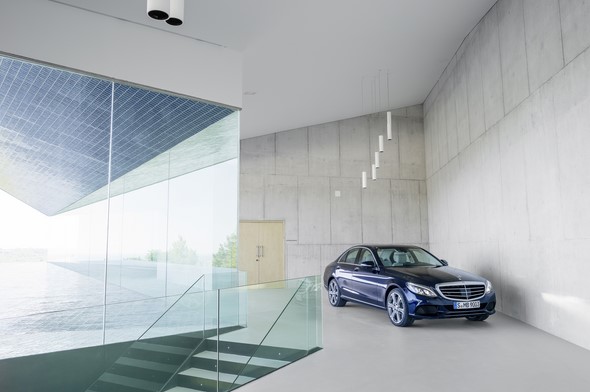
The C 220 BlueTEC is optionally also available with an output of 120 kW (163 hp) as a BlueEFFICIENCY Edition.
All diesel engines of the new C-Class are equipped with the established SCR technology (selective catalytic reduction) for particularly environment-friendly driving, and ensure that the C‑Class models with diesel engines attain at least efficiency class A, and in most cases even efficiency class A+.
The only exceptions are the 4MATIC four-wheel-drive models which are rated as efficiency class B.
BlueDIRECT petrol engines with third-generation direct injection
Four-cylinder petrol engines with power outputs ranging from 115 to 180 kW (156 to 245 hp) will also be available.
These include the C 180 BlueEFFICIENCY Edition special model, which qualifies for efficiency class A. A six-cylinder petrol engine rated at 245 kW (333 hp) will follow in due course.
The BlueDIRECT four-cylinder petrol engines of the C-Class combine spontaneous response and exemplary power delivery with high efficiency and best-in-class emissions.
To this end, Mercedes-Benz has transferred the BlueDIRECT technology from the V6 and V8 engines to the four-cylinder engine.
The direct injection system with spray-guided combustion, first introduced into passenger-car series production by Mercedes-Benz, employs an electronically controlled precision multiple injection process.
The third-generation direct injection technology is complemented by “fast multiple ignition”.
Hybrid with four-cylinder diesel and petrol engine
As in the S and E-Class, Mercedes-Benz offers a diesel engine combined with a hybrid module.
The C 300 BlueTEC HYBRID with four-cylinder diesel engine and compact electric motor generates an output of 150 + 20 kW (204 + 27 hp) and runs on only 3.6 litresof diesel per 100 km/h in NEDC combined mode (provisional figure).
A further particularly economical hybrid model which is to follow at a later juncture will feature state-of-the-art plug-in technology.
Optimised powertrain
Depending on the installed output ratings, Mercedes-Benz offers a new 6-speed manual transmission for the four-cylinder engines in the new C-Class, which stands apart first and foremost by virtue of its enhanced ease of shifting coupled with increased shifting precision and a harmonious gear change sequence.
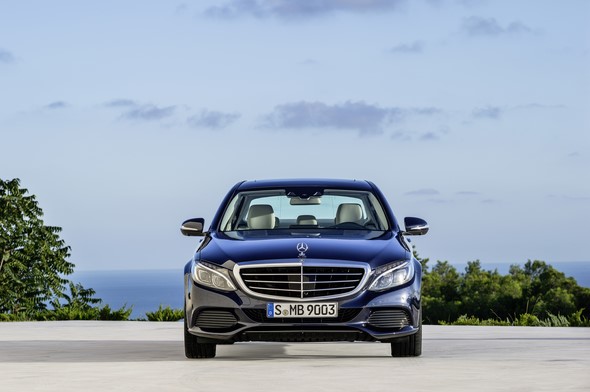
Smooth automatic gear shifting is provided by the 7G-TRONIC PLUS automatic transmission, which has undergone further development at Mercedes-Benz in the interests of enhanced environment-friendliness and driving pleasure.
The 4MATIC permanent all-wheel-drive system, which will be available starting in September 2014, serves to improve traction and driving stability in the C-Class while additionally underscoring the vehicle’s refined sportiness.
Suspension – sporty yet comfortable
The suspension on the new C-Class is a totally new development. It provides for nimble and agile handling that makes driving a great pleasure on winding roads while also offering the highest standard of ride comfort in the segment.
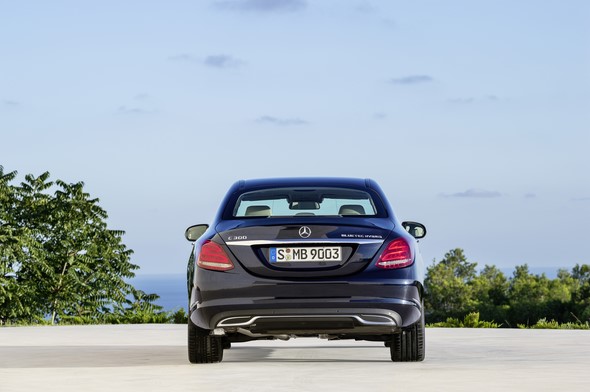
A newly designed 4-link front axle plays a major part in the agile handling characteristics. Thanks to the 4-link principle, the wheel suspension is fully decoupled from the spring strut.
The resultant favourable axle kinematics allow more grip and higher cornering forces. As a result, the suspension responds more sensitively to steering movements and allows a sporty, agile driving style.
An optimised multi-link independent rear suspension with 5‑links ensures unsurpassed wheel location qualities and supreme straight-line stability.
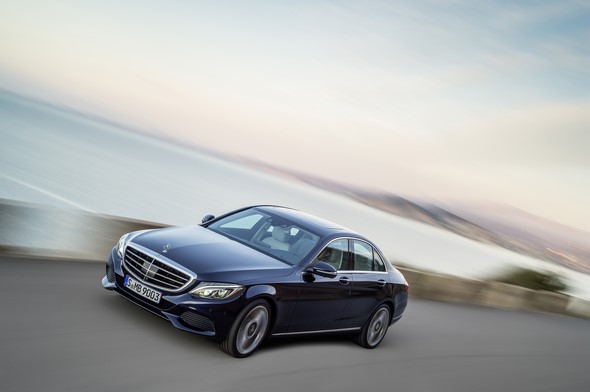
The new C-Class Saloon is fitted as standard with a steel suspension. Three DIRECT CONTROL suspensions with selective damping system are available in conjunction with this suspension:
- a comfort suspension
- a comfortable Avantgarde suspension lowered by 15 millimetres
- a sports suspension lowered by 15 millimetres
First air suspension in this category
The new C-Class is the first vehicle in its segment that can be fitted with an optional air suspension (AIRMATIC) on the front and rear axle.
Thanks to electronically controlled, continuously variable damping at the front and rear, it offers outstanding road roar and tyre vibration characteristics even with the vehicle loaded.
The driver can use a switch to choose between the various characteristics: “Comfort”, “ECO”, “Sport” and “Sport+”. The additional “Individual” setting enables drivers to configure their vehicle according to their own preferences.
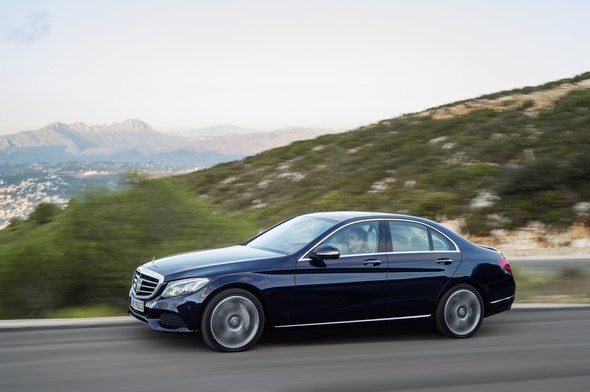
AIRMATIC also features all-round self-levelling for optimum ride comfort even with the vehicle loaded.
The new C-Class also comes with an electric parking brake as standard. This brake is released automatically when the driver ends parking mode with the aim of moving off.
Steering with a sporty character
All models of the C-Class family will feature an electromechanical Direct-Steer system as standard from now on.
This combines road-speed-dependent power assistance from the speed-sensitive power steering system with a steering ratio that varies with the given steering angle.
The power steering assistance provided by the rack-and-pinion steering gear is controlled as needed, thereby contributing towards efficiency.
Mercedes-Benz Intelligent Drive: the intelligent car
It is the declared aim of Mercedes-Benz to make the highest standard of safety available to everyone. To this end, the new C-Class incorporates almost all of the new assistance systems with a host of enhanced functions which celebrated their world premiere in the S-Class and E-Class only a few months ago.
The assistance systems enhance both comfort and safety. Mercedes-Benz calls this Intelligent Drive.
The new C-Class offers numerous innovative safety and assistance systems. It is equipped as standard with ATTENTION ASSIST, which can warn the driver of inattentiveness and fatigue.
On motorways the COMAND Online navigation function offers nearby break options as stopovers, providing the system has been specified in the vehicle.
The ATTENTION ASSIST function offers an adjustable level of sensitivity and can inform drivers in a separate view in the instrument cluster about their level of drowsiness and how long they have been driving since their last break.
In addition to Adaptive Brake Assist, which offers protection from collisions from speeds as low as 7 km/h, standard-fit COLLISION PREVENTION ASSIST PLUS also features an additional function: when the risk of collision persists and the driver fails to respond, the system is able to carry out autonomous braking at speeds of up to 200 km/h, thereby reducing the severity of collisions with slower or stopping vehicles.
The system also brakes in response to stationary vehicles at a speed of up to 50 km/h, and is able to prevent rear-end collisions at up to 40 km/h.
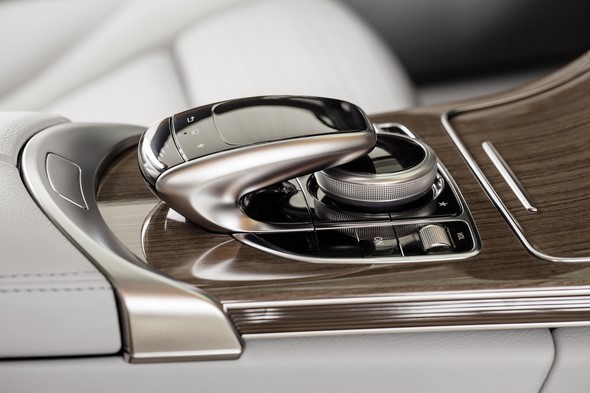
In addition, new assistance systems and existing assistance systems with significantly enhanced functions from the new S-Class and E-Class are also optionally available, combining data from various sensor technologies as part of the Intelligent Drive concept to substantially enhance comfort and safety:
- DISTRONIC PLUS with Steering Assist and integrated Stop&Go Pilot is a semi-autonomous Stop-and-Go assist system, which in addition to using the lane markings is able to follow the vehicle ahead at speeds below 60 km/h, thus providing a safe and convenient means of following the flow of traffic.
- BAS PLUS Brake Assist can now also detect crossing traffic and boost the braking force if the driver fails to apply the brakes sufficiently; the PRE-SAFE® Brake can detect stationary vehicles and even pedestrians, brake autonomously if the driver fails to react and thus prevent accidents at speeds of up 50 km/h and mitigate the severity of collisions at speeds of up to 72 km/h. In flowing traffic the PRE-SAFE® Brake provides assistance according to the same mode of operation throughout the speed range from 7 to 200 km/h.
- Enhanced Active Lane Keeping Assist can now also prevent the vehicle from unintentionally drifting out of lane by applying the brakes on one side when the lane markings are broken and there is a risk of collision, e.g. as a result of vehicles overtaking at high speed, parallel traffic or even oncoming traffic.
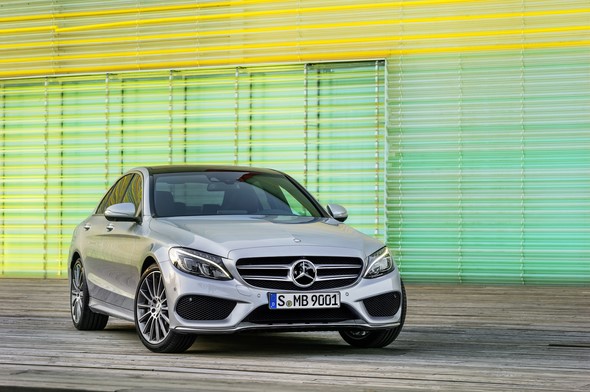
The numerous assistance systems also include
- Active Parking Assist, which enables automated parking with active steering and brake intervention in both parallel and end-on parking spaces
- a 360° camera, which is able to show the vehicle and its surroundings from various perspectives, including a virtual bird’s-eye view
- Traffic Sign Assist with wrong-way warning function, which warns of speed limits and alerts the driver to no-overtaking zones and no-entry signs, as well as
- Adaptive Highbeam Assist Plus, which allows the high-beam headlamps to be kept on permanently without dazzling traffic by masking out other vehicles in the light cone of the high-beam headlamps.
Airbags for safety
In addition to 3-point safety belts with pyrotechnical belt tensioning and belt-force limitation for driver, front passenger and those in the outer rear seats, numerous airbags serve to protect the vehicle’s occupants in an accident.
These include:
- combined thorax/pelvis sidebags for driver and front passenger
- a newly developed windowbag
- sidebags for the outer rear seats (optional)
- a kneebag for the driver
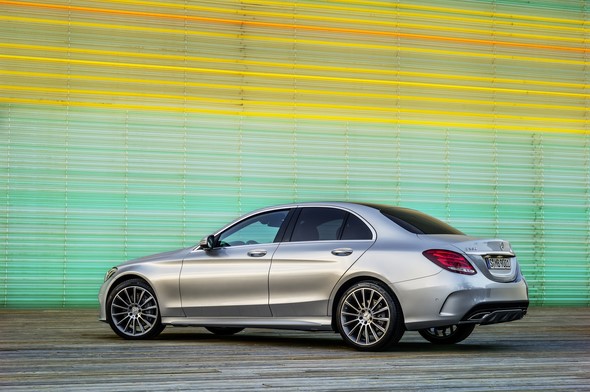
The front passenger seat can additionally be fitted with automatic child seat recognition, which dispenses with the previous transponder in favour of a weight mat.
This enables any child seat to be used. The airbag is automatically deactivated when a child seat is fitted and reactivated once it has been removed.
Air conditioning: signals from space
Mercedes-Benz has systematically advanced and substantially improved the air conditioning system in the new C-Class. This applies in particular to the control quality, performance, efficiency and air quality.
The new C-Class is also the only vehicle in the segment to offer tunnel detection via satellite navigation.
It uses map data from the navigation system and the GPS location data to close the air-recirculation flap automatically when the vehicle enters a tunnel, subsequently re-opening it when the vehicle emerges from the tunnel.
Another highlight contributing to a feel-good atmosphere is the AIR-BALANCE package with active fragrancing, air ionisation and more efficient filtration than is available on the base model.
Vibrant infotainment
A completely new multimedia generation offers intuitive operation in the new C-Class, featuring elaborate animations and visual effects which present all the functions in a clear and highly attractive manner.
Furthermore the new C-Class is equipped with the unique Frontbass system. This avant-garde acoustic system uses the space within the cross-member and side member in the body structure as a resonance chamber for the woofers.
The result is a listening experience almost on a par with a concert hall. A Burmester® surround sound system is optionally available.
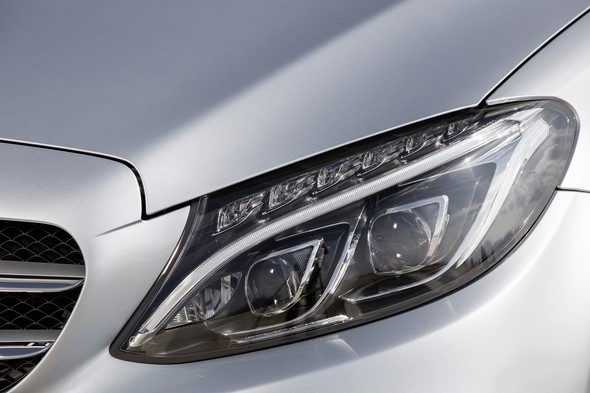
The navigation system presents its contents in interactive mode. Its features include an animated compass, a “Drive Show” with information for passengers similar to the on-screen presentations on board airliners and Google Maps displayed on the head unit.
COMAND Online is now also able to provide more accurate real-time information about the situation on the roads when it receives its traffic data via the internet by means of the “Live Traffic Information” service.
Internet and diverse data sources already available in the basic version
A Bluetooth®-capable mobile phone with data option is all it takes to make the Audio 20 system internet-capable. This enables surfing the internet without restrictions when the vehicle is stationary.
Mercedes-Benz Apps such as Weather, GoogleTM Local Search with StreetView and Panoramio, destination/route download and Facebook can be used while on the move in conjunction with COMAND Online.
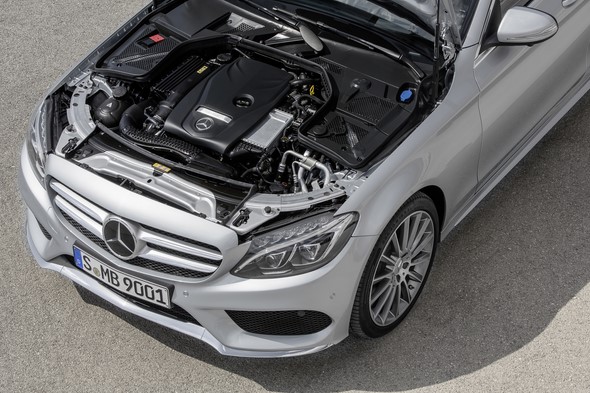
Audio and video playback is possible from various sources, for example, via Bluetooth®, from an Apple iPod or iPhone®, from an SD card, USB stick or CD/DVD (with Audio 20 CD or higher and with COMAND Online).
COMAND Online with hotspot functionality
COMAND Online not only offers a larger display with a resolution of 960 x 540 pixels and a special bonded glass cover such as is familiar from consumer devices like the iPhone® or iPad.
It also enables digital TV / radio reception, for example, and offers a host of other features including fast hard-disc navigation, automatic tailback avoidance via up-to-date and accurate “Live Traffic Information” traffic data, integrated WLAN hotspot functionality and the LINGUATRONIC voice-operated control system.
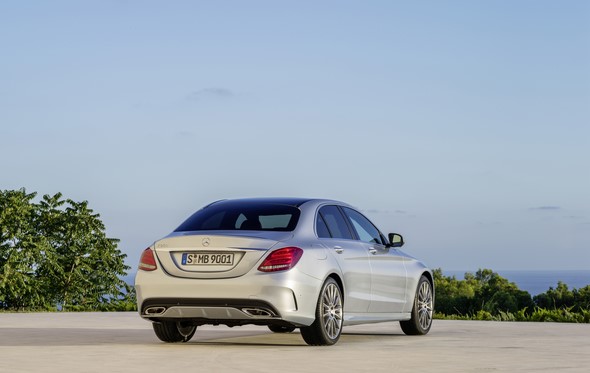
Telephony via Bluetooth® as standard
The basic system Audio 20, the Audio 20 CD and COMAND Online all come with a basic telephony feature as standard, which connects the mobile phone with the vehicle via a standardised Bluetooth® interface.
Model range
The new C-Class – one class higher
With the all-new C-Class Mercedes-Benz is defining new benchmarks in the premium medium-size category.
A sensuous, clear design, a sporty interior with high-class appeal and a generous sense of space, the lightest body shell in the segment, economical and lively engines, efficiency benchmarks, extensive safety features, a new agile and comfortable suspension as well as a host of other innovations create the impression of an upgrade to a higher class of vehicle.
The new C-Class has a sensuous and clear design and offers a host of technical innovations as well as a comprehensive scope of standard equipment, and exemplary emissions and fuel consumption figures.
This all adds up to substantial added value and long-term savings on motor vehicle tax and at the filling station.
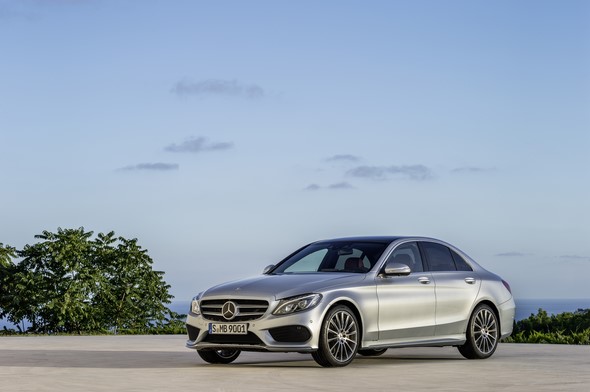
Production of the new C-Class starts in four locations and on four continents within the span of four months: in Bremen (Germany), East London (South Africa), Beijing (China) and for the first time also in Tuscaloosa (Alabama, USA).
New dimensions
The new C-Class offers new dimensions with regard to technology, ecology, comfort, high-class appeal and fun at the wheel – and equally regarding the sense of space. The C-Class has grown to take account of people’s increasing average height.
With an 80-millimetre increase in the wheelbase (2840 millimetres) compared with the previous model, the vehicle is 95 millimetres longer (4686 millimetres) and 40 millimetres wider (1810 millimetres).
The resulting increase in space benefits the rear-seat passengers, who now travel in even more comfort, and creates room for the new front axle and future hybrid components.
At 480 litres the new C-Class also surpasses its predecessor in terms of boot capacity (in accordance with ISO 3832).
In some measurements the new C-Class even approaches or surpasses the E‑Class model series that made design history in 1995 with its distinctive four-headlamp look.
Wheelbase, track and width are actually larger while many interior dimensions are on about the same level. This growth spurt benefits first and foremost comfort.
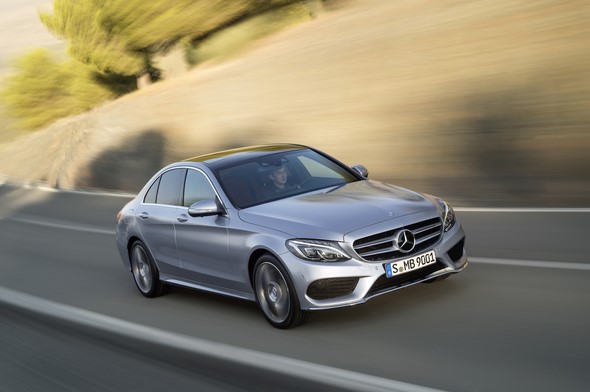
What is more, the bare figures substantiate that the new C-Class Saloon also provides the measurable and not purely subjective benefits of an “upgrade to a higher class of vehicle” thanks to high-quality appointments and innovative technology.
Comparison of measurements
| C-Class predecessor(W 204) | The new C-Class(W 205) | 1995 E-Class(W 210) | |
| Wheelbase mm | 2760 | 2840 | 2833 |
| Track front/rear mm | 1547/1547 | 1588/1570 | 1542/1536 |
| Length mm | 4591 | 4686 | 4795 |
| Width mm | 1770 | 1810 | 1799 |
| Height mm | 1447 | 1442 | 1433 |
| Elbow room front mm | 1440 | 1454 | 1452 |
| Elbow room rear mm | 1462 | 1462 | 1472 |
The new C-Class sets visual highlights with a striking, dynamic design that exudes sensuous clarity while arousing emotions at the same time.
Customers can choose from two fronts – sporty with a central star or – reserved solely for the EXCLUSIVE line – the classic Saloon grille with the Mercedes star on the bonnet, which puts particular emphasis on the status and reputation of the Saloon.
The interior spaciously and stylishly showcases straightforward sportiness and aesthetic elegance with high-quality materials and finely crafted details worthy of the luxury class with surprising new design ideas.
In addition to the base model, there are also three distinct design and equipment lines each for the exterior and interior.
With regard to technical features the new C-Class surpasses its successful predecessor in many areas and sets a multitude of new benchmarks in its segment besides.
With an aluminium content of 48 percent and up to 100 kilograms lighter the Saloon is the lightweight-design leader in its segment.
Other benchmarks: 99 grammes of CO2 emissionsfor the C 180 BlueTEC and the C 200 BlueTEC (preliminary figures); for the C 300 BlueTEC HYBRID 94 grammes of CO2 emissionsas well as a Cd value of 0.24.
Among the outstanding characteristics of the new C-Class are also the best ride comfort – especially with first-ever AIRMATIC air suspension in this segment – the best NVH figures (noise, vibration, harshness) for comfort and driver-fitness safety, the best wind noise index, the most advanced and extensive assistance systems, innovative technology with multifunctional touchpad, head-up display, and GPS-controlled climate comfort.
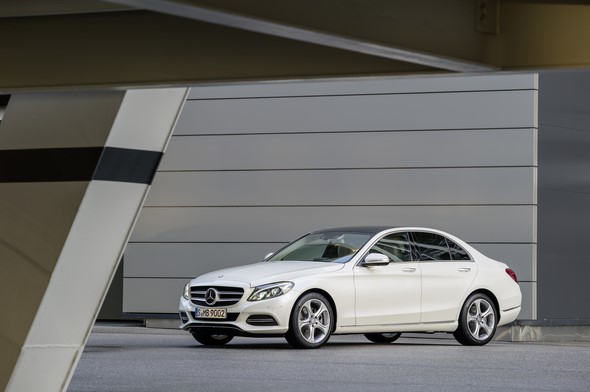
The outstanding safety substantiates the high standards which Mercedes-Benz as a safety pioneer also satisfies in the new C-Class – it not only garners benchmarks in all national ratings around the world, but also meets the even more demanding Mercedes in-house requirements, which even more precisely reflect what actually happens in real-life accidents.
C-Class customers will have a choice of three versions of the standard-specification steel suspension, which also includes a very sporty set-up. As an alternative Mercedes-Benz for the first time offers an air suspension in this segment.
The AIRMATIC air suspension manages to bridge the gap between a high level of ride comfort and dynamic-agile handling.
Efficient and lively engines
Powerful and efficient petrol and diesel engines, all equipped with the ECO start/stop function and complying with Euro 6 emissions standards, provide for lively performance and great fun at the wheel.
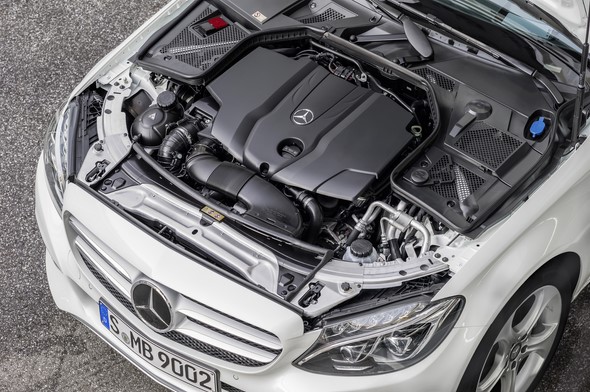
They are also a factor in cutting fuel consumption by up to 20 percent compared with the preceding model. Among them is also a new small four-cylinder diesel engine with a displacement of 1.6 litres.
Low weight, compact design and low specific fuel consumption are among its special merits.
Five four-cylinder petrol engines with power outputs ranging from 115 to 180 kW (156 to 245 hp) will initially be available for the new C-Class.
There is also the C 180 BlueEFFICIENCY Edition special model, which with ECO Technology package qualifies for efficiency class A.
A six-cylinder petrol engine rated at 245 kW (333 hp) and the four-cylinder C 350 HYBRID with plug-in technology and a power output of 150 + 20 kW (204 + 27 hp) will follow in due course.
The diesel models of the new C-Class are powered by the further enhanced four-cylinder or the new small four-cylinder engine, which as BlueTEC models are all equipped with SCR technology (selective catalytic reduction).
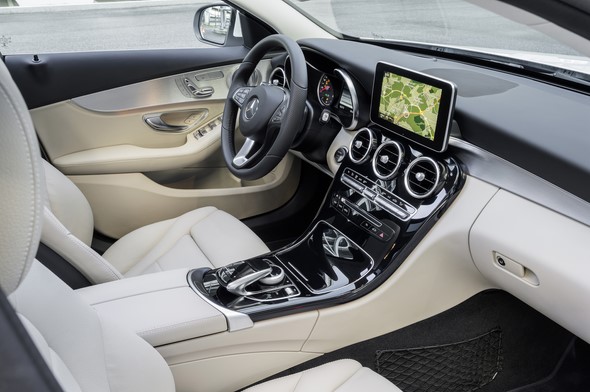
They cover an output range from 85 kW (115 hp) to 150 kW (204 hp). The C 220 BlueTEC is optionally also available with an output of 120 kW (163 hp) as a special model with ECO Technology package.
In addition, Mercedes-Benz offers a diesel engine combined with a hybrid module. The C 300 BlueTEC HYBRID with four-cylinder diesel engine and compact electric motor generates an output of 150 + 20 kW (204 + 27 hp) and despite its high power output runs on just 3.6 litres of diesel per 100 km/h in NEDC combined mode (equivalent to 94 grammes of CO2).
As is customary, the new C-Class will also be available with a modern 4MATIC all-wheel-drive system starting in September 2014.
All diesel-powered C-Class models are classified at least as efficiency class A, most of them even as efficiency class A+. The only exceptions are the 4MATIC models C 220 BlueTEC 4MATIC and C 250 BlueTEC 4MATIC, which are classified as efficiency class B.
HIGHLIGHTS
- Striking, dynamic design exudes sensuous clarity and arouses emotions at the same time.
- Longer wheelbase, increased length, more width – this means more room in the interior
- Technology leap with intelligent lightweight design and high aluminium content. Up to 100 kilograms lighter. This makes the new C-Class the “lightweight construction leader” in its segment.
- Sporty-agile suspension with new 4-link front axle
- First-ever air suspension with continuous damper adjustment
in this segment
- Best-in-class aerodynamics: Cd value 0.24.
- Progressive, emotional exterior – choice of the sporty radiator grille with integral Mercedes star and the classic radiator grille with the Mercedes star on the bonnet
- High-quality, authentic materials and trim elements characterise the sporty interior that exudes modern luxury
- Modern operating convenience with rotary/push controller, touchpad, head-up display and internet-capable navigation and entertainment system with large colour display above the centre console
- High level of safety with virtually all new driving assistance systems from the E and S-Class
- Sophisticated crash management meets all national requirements worldwide
- Benchmark for NVH (noise, vibration, harshness)
- Unique Frontbass system for concert hall atmosphere
- Climate comfort with automatic air recirculation via GPS
- Newly developed economical 4-cylinder diesel engine with a displacement of 1.6 litres
- All engines already comply with EURO 6 emissions standards
- All engines with ECO start/stop function
- High energy efficiency of ancillaries such as air conditioning system, clutch and refrigerant compressor
- Special models (BlueEFFICIENCY Editions)
- Available as a mild hybrid (C 300 BlueTEC HYBRID)
- New six-speed manual transmission with high shift comfort
- 7G-TRONIC PLUS with dynamic response and reduced consumption
- Controlled radiator shutters for less drag
- Optional full-LED headlamps
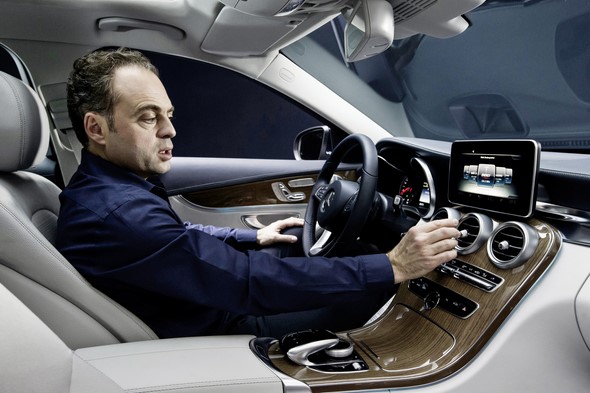
Design
Sensuous clarity and purist forms
On a visual level, the new C-Class represents a bold departure from its predecessor. Its emotional, sensuous surface geometry deliberately displays a degree of tension and as a result appears muscular and full of character.
At the same time the design showcases the high-tech character in a purist, clear and exciting fashion.
Intelligence and emotion – these two polar opposites define the design of the Mercedes-Benz brand. The design of the new C-Class is a statement of this current Mercedes-Benz style of design.
On the one hand, modern aesthetics were the source of inspiration for the new Saloon’s sensuous lines and surfaces, whose harmony and dynamic spirit touch everyone directly.
On the other, the designers have created minimalist, purist forms for the C-Class which emphasise its intelligent technology and engineering.
Consequently, progressive and emotional highlights underscore the ground-breaking design style of the new C-Class and demonstrate sensuous clarity.
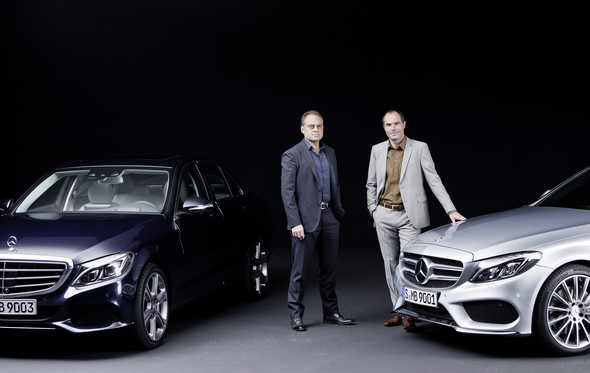
A long bonnet, a passenger compartment sitting far back and short overhangs characterise the classic, balanced Mercedes-Benz Saloon proportions of the C‑Class.
The distance from the front wheel arch to the door opening, which is a measure of comfort, is unusually large for this segment in the case of the new C-Class.
Large wheels emphasise the rear end and create the impression of stylish sportiness. Visually the car has a powerful road stance.
Muscular and sensuous
The clearly defined surfaces also deliberately display a degree of tension, lending them a modern and at the same time emotional character.
A strong indent in the C-pillar forms a powerful shoulder, which is distinctly sculpted and gives the impression of an athletic muscle.
It is emphasised by a soft edge that trails off in the tail lamp. All in all the vehicle body appears powerful but defined by engineering, and conveys dynamic sportiness.
Precise lines and sculptural surfaces create lively light and shadow effects. Viewed from the side, the dropping line highlights the vehicle’s proportions as a hallmark Mercedes signature.
In tandem with a counter-line rising in the lower part of the vehicle from the front wheel, it creates a formal sense of tension.
The counter-line makes the vehicle appear longer, encompasses the rear and ultimately flows over the sides and into the bumper creating a sense of balance.
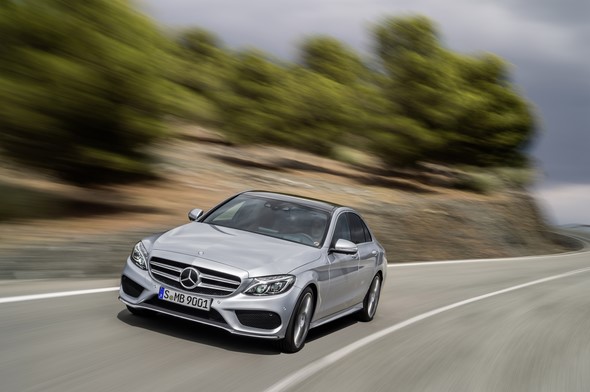
A high, tense beltline serves as the third side line and visually reduces the height of the side windows. A non-continuous trim strip in the area of the rear window with a consequently high-quality appeal emphasises the C-pillar.
The AVANTGARDE and EXCLUSIVE lines are upgraded in addition with a trim strip above the door that tapers off towards the front.
A large selection of light-alloy wheels with diameters between 40.6 cm (16 inches) and 48.3 cm (19 inches) underscores the stylish sportiness of the new C-Class.
Two new fronts to choose from
Depending on the exterior design and equipment line, customers can choose from different front-end designs – with a striking, wide sports grille and central star or with a classic radiator grille with the star on the bonnet.
- The standard equipment and AVANTGARDE design and equipment line include the sports grille with twin louvres, which emphasises the long bonnet and therefore the vehicle’s power and dynamic nature.
- The classic radiator grille, which is reserved solely for the EXCLUSIVE line, stands for status, refinement and modern luxury. Its sightly taller radiator grille, in which three horizontal louvres and one vertical louvre appear to float, is framed by a three-dimensional chrome surround. The commanding Mercedes star on the bonnet underscores the effortless superiority.
Large air intakes in the bumper hint at the high air flow requirements of the performance engines and underscore the sense of width and sportiness of the front end.
Clearly drawn headlamp contours round off the strong character of the trademark front of the new C-Class.
The LED daytime running lamps are integrated into the headlamp in the modern torch design of Mercedes-Benz, giving this element the effect of an eyebrow that lends the new C-Class an energetic, confident “gaze”.

The new C-Class comes with H7 halogen headlamps as standard. Two energy-saving LED headlamp variants are optionally available: a static and a dynamic version with “LED Intelligent Light System” and Adaptive Highbeam Assist, which for the first time makes driving with permanent high-beam possible by masking detected road users in the cone of light.
Their characteristic night design lends the new C-Class its very own distinctive look in the dark, too.
Rear end with powerful shoulders
The clear design emphasising width and the powerful shoulders give the new C-Class a decidedly athletic appearance from the rear.
A soft edge which merges into the tail lights accentuates the indent in the C-pillar which is essential for the powerful shoulder.
A strongly vaulted spoiler lip on the boot lid has a positive effect on the Cd value, and also characterises the appearance.
The horizontally oriented tail lights are precisely embedded in the side wall and the bumper and wrap around the edges of the vehicle’s rear end.
As a result they visually emphasise the width of the vehicle.
The brake lamp is positioned between the rear reflector and the tail lamp. Its light intensity varies between daytime and night-time within legally permissible limits.
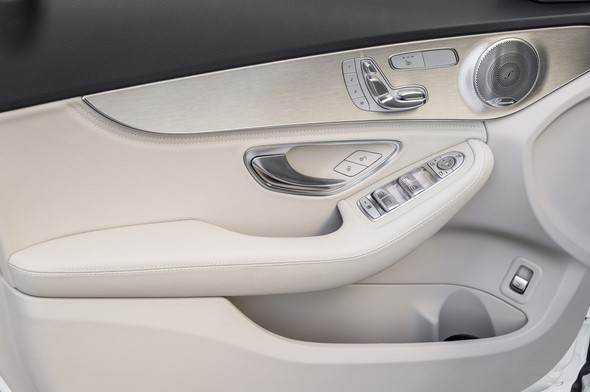
The two-beam-look of the night design is very distinctive and gives the rear end an unmistakable identity in the dark as well. The tail lamps are available with partial or full LED technology.
A horizontal chrome strip as a styling element emphasises the licence plate recess positioned between the tail lamps in hallmark Mercedes fashion.
Three-dimensional tailpipes integrated flush into the bumper have a high-value and sporty appeal, and add the finishing visual touches to the vehicle.
Together with the lower wing they form a single unit and thus create a special effect, making the rear end a true eye catcher.
Interior
Upgrade inside
The cockpit and passenger compartment come across as clear, sensuous and with a host of new unusual styling details.
Clarity stands for visible high-tech attributes and straightforward sportiness – purism in the best sense of the word.
Sensuousness stands for design ideas with exciting flowing shapes and high-grade materials – a reinterpretation of contemporary luxury.
The Mercedes-Benz designers have styled the interior on a level which is rarely found even in higher vehicle categories.
This applies to the painstaking choice of select, high-class materials and their pleasant touch and feel as well as the precision of the finely crafted details.
The interior also embodies a new design idiom which perfectly combines sensuousness and clarity with dynamic sportiness and contributes to the extraordinary high-class appeal of the interior.
Courage to embrace the new
The designers pick up key traits of the exterior inside the vehicle in order to achieve this overall objective. This applies above all to the scintillating play of contrasts between the clearly sculpted lines and surfaces which grow organically from them.
The hallmark contemporary Mercedes-Benz design idiom of the dropping line sloping to the rear is, for instance, picked up in the doors.
At the same time, the style-defining new interior of the new C-Class meets the most discerning design expectations which are today characterised by devices such as high-end smartphones and tablets.
Thus the driver and passengers in the new C-Class enjoy a generous sense of space and unobtrusive, modern luxury whose clear-cut style fits in with contemporary tastes.
The upshot is a new feel-good character in this category – take a seat in the new C-Class and the sensation is something akin to an upgrade from economy to business class on an airliner.
Mercedes-Benz not only raises the character and perceived value of the interior to a new level for this category with the new C-Class.
At the same time, the premium brand also consciously demonstrates through the interior styling the courage to embrace the new in many respects, to adopt a forward-looking vision, thus making an almost radical break with the previous norms in this hitherto rather rational category.
A sweeping centre console as from a single mould
The interior skilfully combines the architecture of the Mercedes-Benz sports cars with a newly interpreted, sporty and flowing centre console design.
As a DIRECT SELECT selector lever handles gear selection on vehicles with automatic transmissions, a large, one-piece centre console panel sweeps elegantly from the centre air outlets to the equally new touchpad in the handrest above the controller on the centre tunnel.
These continuous clear-cut lines create an open sense of space, conveying an unrivalled sense of simple and purist modernity.
The large solitary component is available in numerous material finishes – such as with contemporary wood surfaces, precisely bordered by a chrome surround, or with an exclusive piano-lacquer look – and characterises the interior’s unique ambience with its avant-garde yet sensuous character.
The three-dimensional shape of the genuine wood veneers in the centre console conveys modernity and fine craftsmanship.
The cover of the stowage compartment, for example, is precisely cut from the veneer of the centre console with virtually no material waste to ensure the individual wood grain continues in the cover without a visual break – the surface of the centre console consists in fact of a single piece of wood veneer.
On vehicles with manual transmission the centre console is slightly steeper and features two separate trim elements in order to create ample space for ergonomic operation of the shift lever.
The progressively styled centre console provides an extremely fluid transition to the instrument panel and beyond into the doors. As a result, visually soft volumes ensconce the passengers and equally convey a sense of security and sportiness.
A wing-like trim element separates the upper and lower section of the sporty designed, broad instrument panel. Its design makes it seem to be floating in the air.
Skilfully staged ambience lighting further emphasises this floating effect. The visual separation makes it furthermore possible to choose different material and colour combinations for an individual feel-good atmosphere.
Elevated sportiness and high-value appeal
A centrally positioned free-standing central display is the main eye-catching feature above the centre console – with a screen diagonal of 17.78 centimetres (7 inches), or 21.33 centimetres (8.4 inches) if COMAND Online is specified.
Both versions float in the best ergonomic position above the centre console and are connected to it elegantly with a slim horizontal trim piece.
Thanks to its ergonomic positioning, the eye easily adapts to the central display. Its surface is completely protected by a glass cover for the first time and is bordered by a galvanised silver shadow frame.
Visualisations and animations on the central display enhance the operating convenience and make the functions of driver assistance and communications systems tangible.
A high-quality analogue clock is optionally integrated into the centre console below the upper control panel – an indication of exclusivity and craftsmanship.
The touchpad in the brand-characterising handrest of the central controller in new C-Class was developed by Mercedes-Benz and marks an evolutionary step. As on a smartphone, all the head-unit functions can be operated using finger gestures.
Five round air vents with central adjustment knobs and horizontal louvre insert lend the instrument panel a sporty touch.
The five ventilation outlets in silver shadow with their metallic ‘cool-touch’ effect contrast with the warm look of the other materials – such as the wood in the centre console or the leather on the dashboard.
Three-dimensional trim elements emphasise their high-value appeal – as does the carefully crafted topstitching, for example on the upper section of the instrument panel, the door centre panels and the upper body edge at window level.
The door panelling has also been redesigned and is characterised by high-grade materials as well as a striking surface grain and eye-catching curves.
The driver sits behind a wheel that comes in different designs depending on the selected design and equipment line.
While each variant features a leather-trimmed 3-spoke steering wheel with 12 function keys, their distinct colours and materials boost the character of the respective design and equipment lines.
The leather-trimmed steering wheel of the new AMG Line has a flat bottom. In this way the interior makes extensive differentiation between the polar opposites of”tangible contemporary luxury” and “sensuous clarity” possible.
All switches feature a three-dimensional design befitting a luxury vehicle. High-gloss black, genuine metal and galvanised surfaces, as well as effect paintwork matching the interior appointments colours form a key element of the high-value appeal.
Surfaces with uniform styling and a minimal number of switches provide a serene, reassured sense of space. Another example of the attention to detail is provided by the loudspeaker covers.
Their delicate structures are elaborately photo etched and bordered by a surround made from genuine stainless steel.
Attractive and sporty seats with seat cushion length adjustment
Already the standard-fit sporty front seats underscore the sporty character of the new C-Class. They offer more comfort in the shoulder area and their special shape is a factor in the expanded legroom for the rear passengers.
Their height adjustment range increased by ten millimetres compared with the preceding model series. The head restraints can be moved fore and aft and their height can be adjusted by about 55 millimetres via four detents.
“Cobra-look” front seats with an organic, sporty design and integral head restraint are available for the AVANTGARDE, EXCLUSIVE and AMG Line design and equipment lines.
For the first time the front seats can also be ordered with a seat cushion whose length can be adjusted by 60 millimetres, which offers even more options of finding the perfect seating position.
A large selection of seat covers with a variety of materials (e. g. fabric, fabric/Artico, Artico, leather) and refined colour combinations help C-Class customers to configure their vehicles to best suit their individual preferences.
High-strength steels and intelligent lightweight construction are the technical distinguishing marks of the sturdy rear seats.
Their newly designed seat cushions furthermore enhance the comfort for the rear-seat passengers who also enjoy considerably more legroom and knee room.
The backrest of the rear seat can be folded with a 40/20/40 split. A folding armrest is integrated in the middle. Compared with the predecessor it offers more stowage space and a larger cupholder.
The three height-adjustable head restraints also provide improved rearward visibility.
The following optional extras are available independent of the selected design and equipment line:
- Seat Comfort package with 4-way lumbar support, manual seat cushion length adjustment and electric seat cushion angle adjustment
- Fully electric 12-way seat adjustment with Memory package
- Three-stage seat heating with automatic intensity reduction/deactivation for seat cushion and backrest
- Seat climate control with seat ventilation and reversible air flow, as well as seat occupancy and child seat recognition in the front passenger seat
The automatic child seat recognition system omits the previous transponder and uses a weight mat instead. This enables any child seat to be used. The airbag is automatically deactivated in this case and reactivated once the child seat has been removed.
Interior lighting with LED technology
The interior lighting uses primarily long-lived and energy-saving LED technology. This also applies to the optionally available ambience lighting in the three colours solar (amber), polar (ice blue) and neutral (white), which are selected via a menu item on the head unit and can be set to five brightness levels.
In addition to the lighting elements in the dashboard console panel and on the door trim, the ambience lighting also includes illuminated outer door sill panels, for example.
Stowage concept for even more interior space
A sophisticated stowage concept with extensive stowage options unrivalled in this segment contributes to carefree travelling. The stowage volume in standard specification increased from 19.3 litres for the predecessor to now 29.0 litres (manual gearbox) and 30.2 litres with automatic transmission.
More space – this principle also applies to the stowage facilities in the front doors, for example. Compared with the predecessor their volume on each side increased from 1.4 to 4.6 litres.
Touchpad
Commands with finger-tip control
The touchpad in the new C-Class developed by Mercedes-Benz marks an evolutionary step. As on a smartphone, all the head-unit functions can be operated using finger gestures.
The 65 x 45 millimetre control surface of the new touchpad made out of scratch-resistant material is built into the handrest on the central control panel and bordered by a high-quality metal support – a design feature with a high-tech feel which exudes luxury at the same time.
While other solutions with a touch-sensitive surface only support selected operating steps, the driver and front passenger can use the touchpad in the new C-Class to control all the functions in the central infotainment control panel using the kind of single and multi-touch finger gestures familiar from smartphones and tablet PCs.
Slow and fast gestures are possible. The touchpad also permits letters, numbers and special characters to be entered in handwriting – in any language supported by Audio 20 or COMAND Online.
The user receives clear tactile feedback when operating the touchpad control surface. Characters entered using the handwriting function can also be read aloud by the system, thus supporting blind operation.
The acoustic output also ensures that drivers do not need to take their eyes off the road, keeping distraction to an absolute minimum.
Users can input commands reliably with their hand sitting firmly on the ergonomic handrest without any need for hovering fingers. A new handrest detection feature also increases operating safety and helps prevent incorrect inputs.
To this end the system analyses a sensor signal in three dimensions, thus detecting whether the hand is simply being placed on the handrest or is actually inputting data.
The icons on the control surface are illuminated in the dark to help the user locate the various functions.
Three touch-sensitive buttons are arranged behind the touchpad which can be used to operate key functions quickly and directly (back function, switch to favourites menu, audio quick menu).
The touchpad in the C-Class thus offers an additional, fully fledged and innovative input option to complement the existing controller and the LINGUATRONIC voice-operated control system.
Users can choose at any time which input method they prefer.
Design and equipment lines
In addition to the standard specification, the new C-Class offers new design and equipment lines. There is a choice of:
- The AVANTGARDE line – it features contemporary, dynamic characteristics that define the C-Class as a sporty Saloon.
- The EXCLUSIVE line – it expresses the elevated status with classic sophistication.
- The AMG Line design and equipment line – it lends the C-Class a commanding, sporty appearance.
The most important characteristics of the lines at a glance
| Exterior | ||
| AVANTGARDE | EXCLUSIVE | AMG Line |
| Radiator grille with integral Mercedes star, two matte iridium silver louvres and chrome inserts | Classic tall radiator grille with three-dimensional frame, front louvre cross barsand vertical bar in chrome, rear louvres high-gloss black,Mercedes star on the bonnet | Radiator grille with integral Mercedes star and two louvres with chrome inserts |
| Front bumper with chrome trim and air intakes with diamond mesh and dual chrome trim strip | Stylish-sporty front bumper with chrome trimand air intakes with high-gloss black louvres | AMG front apron with sporty-distinctive air intakeswith diamond mesh and chrome trim |
| Side skirts painted in vehicle colour with chrome inserts | Side skirts painted in vehicle colour with chrome inserts | AMG side skirts |
| Window frame and waistline trim strip in polished aluminium | Window frame and waistline trim strip in polished aluminium | Window frame and waistline trim strip in polished aluminium |
| High-gloss black facing on the B-pillars and bar on rear side windows | High-gloss black facing on the B-pillars and bar on rear side windows | High-gloss black facing on the B-pillars and bar on rear side windows |
| Rear bumper with black diffuser-look insert | Rear bumper with black diffuser-look insert | Diffuser-look AMG rear apron with inserts in vehicle colour |
| Suspension with selective damping system and ride-height lowering | Suspension with selective damping system | Sports suspension lowered by 15 mmSports Direct-Steer systemCross-drilled front brake discs Front brake callipers with “Mercedes-Benz” lettering |
| 43.2-cm (17-inch) 5-twin-spoke light-alloy wheels | 43.2-cm (17-inch) multi-spoke light-alloy wheels | 45.7-cm (18-inch) 5-spoke AMG light-alloy wheels, painted in titanium grey witha high-sheen finish |
| Interior | ||
| AVANTGARDE | EXCLUSIVE | AMG Line |
| Seats with ARTICO man-made leather/fabric upholsteryNorwich black or crystal grey | Seats with ARTICO man-made leather/microfibre upholsteryDINAMICA/Nottingham fabric | Sports seats with black ARTICO man-made leather upholstery,centre panel of seat and backrest perforated to provide contrast |
| Three-spoke multifunction steering wheel in nappa leather, in the centregrip area with deep indentation | Three-spoke multifunction steering wheel in black, deep-sea blue or espresso brown nappa leather | Three-spoke multifunction sports steering wheel in black nappa leather, withflat bottom and deep indentation in the centre grip area |
| Upper section of instrument panel in black and lower section in black or silk beige | Upper section of instrument panel and upper edges at window level in black, deep-sea blue or espresso brown ARTICO man-made leather and contrasting topstitching | Upper section of instrument panel and upper edges at window level in black ARTICO man-made leather and contrasting topstitching |
| Aluminium horizontal trim in the instrument panel and the doors with light-coloured longitudinal grain | Horizontal trim in the instrument panel in silver shadow galvanised,light brown linestructure high-gloss lime wood trim in the doors | Aluminium horizontal trim in the instrument panel and the doors with light-coloured longitudinal grain |
| Trim in the centre console in black piano-lacquer look | Trim in the centre console in light brown linestructure high-gloss lime wood | Trim in the centre console in black piano-lacquer look |
| with manual transmission, shift lever in nappa leather with silver chrome brace,shift gaiter in nappa leather with topstitching | with manual transmission, shift lever in nappa leather with galvanised brace,shift gaiter in nappa leather with topstitching | with manual transmission, shift lever in nappa leather with silver chrome brace,shift gaiter in nappa leather with topstitching |
| Door centre panels in black, crystal grey/black or silk beige/black ARTICO man-made leatherwith contrasting topstitching | Door centre panels in black, crystal grey or silk beige DINAMICA microfibre with contrasting topstitching | Door centre panels in ARTICO man-made leather with contrasting topstitching |
| Crystal grey or porcelain fabric roof liner | Crystal grey or porcelain fabric roof linerBlack, deep-sea blue or silk beige carpeting | Black fabric roof linerBlack floor mats with AMG lettering |
| Interior Light package | Interior Light package | Interior Light package |
| Brushed stainless-steel AMG sports pedals with black rubber studs |
Head-up display
Info in focus
A head-up display is a new feature in the C-Class. As in a fighter jet, it projects important information directly into the driver’s field of vision on the windscreen, ensuring that there is less distraction from the road ahead.
The system informs about vehicle speed, posted speed limits, navigation instructions and DISTRONIC messages.
The technology is based on mirror optics and a full-colour display module with a resolution of 480 x 240 pixels which is driven by high-power LEDs.
They project the virtual image, which measures around 21 x 7 centimetres, into the driver’s field of vision where it appears to float above the bonnet around two metres away.
The resolution of more than 60 pixels per degree of viewing angle ensures a needle-sharp image.
A light sensor located near the top edge of the roof automatically adjusts the brightness of the head-up display to the exterior lighting conditions. Brightnesses of 10,000 cd/m² plus can be achieved on sunny days.
Because the contrast ratio is better than 1000:1, the system produces a high-quality display even in the dark.
The driver can adjust the height of the virtual image so that it can be read easily. On vehicles with seat memory function this feature stores the individual settings.
A range of display content can also be enabled or disabled, and the brightness of the display adjusted individually.
The special head-up windscreen with its wedge-shaped laminated foil eliminates double images produced by reflections on the outer and inner boundary surfaces of the windscreen.
It superimposes the secondary image, which is produced on the outer surface, onto the primary image. This offset depends on the particular angle and has been optimised for a driver in a normal seating position.
Body
Rigid body – lightly done
Less weight, excellent rigidity for superb handling coupled with optimum noise and vibration characteristics as well as high crash safety – the body shell of the new C-Class provides an innovative base which also facilitates new fuel consumption benchmark figures.
Lighter cars are more efficient. That is why Mercedes-Benz has substantially reduced the weight of the new C-Class. Thanks to intelligent and innovative lightweight construction, the aluminium hybrid body is around 70 kg lighter than with conventional fabrication using steel.
The vehicle’s overall weight is even reduced by around 100 kilograms. As such, the new C-Class leads the “lightweight rankings” in its segment.
This spawns numerous benefits: the lightweight construction of the new C-Class cuts fuel consumption by up to 20 percent without any loss of performance, while at the same time enabling a lower centre of gravity, which in turn gives rise to the Saloon’s noticeably sporty and agile handling.
Mercedes-Benz achieved this technological leap primarily through an entirely new design and the extensive use of aluminium, hot-formed steel parts and ultra-high-strength steels – an unusual combination in volume-production vehicles.
The proportion of these materials has therefore increased noticeably compared with the successful predecessor.
Previous model series New C-Class
Aluminium (sheet metal and cast) 9% (4%) 48% (24%)
Hot-formed steel parts 3% (4%) 8% (12%)
Ultra high-strength steels 3% (3%) 4% (4%)
Figures in percent of surface area (percentage of weight)
Simply by using these materials, the weight of the body shell structure has been reduced by some 40 kilograms compared with the outgoing Saloon.
Moreover, virtually the entire outer skin, consisting of front wings, bonnet, boot lid, doors and the roof panelling, has been made from aluminium sheets, thus helping reduce weight further.
The multifunction recess is made from glass mat-reinforced thermoplastics (GMT).
The body shell engineers delivered further benefits – both in terms of weight and as regards other important body characteristics – by means of an intelligent lightweight construction concept.
As part of this process, they have redesigned each detail optimally and not simply replaced steel with aluminium.
After all, the specification not only required a reduction in weight, but also called for a body shell which in many respects sets new, challenging standards, with hitherto unprecedented performance in this segment – for instance the high rigidity at the load introduction points from the suspension to the body or in relation to the NVH (noise, vibration, harshness) characteristics. This is a major factor in optimising road noise.
New body shell concepts proved the most direct way of meeting these requirements. For instance, the designers exploited the greater design leeway offered by die-cast aluminium compared with steel.
The body consists, among other things, of nine large die-cast components. The same designers also managed to integrate and merge various elements into a single die-cast component, which with conventional design would have to be made up of several steel parts.
In this way a host of functions can be realised in a single component and installation space put to optimum use. For instance, all shock absorbers at the front and rear of the vehicle are mounted on such rigid aluminium die-cast components.
Other design details include larger cross-sections as well as precisely calculated stabilising beads in the floor and bulkhead. High-strength adhesives are used extensively to firmly bond the parts, which in turn helps increase the rigidity of the body.
Body and body shell clearly exceed the values for overall vehicle rigidity, which are traditionally outstanding for Mercedes-Benz, and set a new benchmark in this segment.
As a result, the ambitious goals regarding driving dynamics and noise level have even been exceeded.
The new C-Class also meets the highest requirements regarding the quality appeal directly experienced by customers. For instance, the body pleases with precise gaps and radii.
Safety takes precedence
In keeping with Mercedes-Benz traditions, the body shell is designed for exemplary crash safety. The Saloon not only meets all current national and international laws, but also all rating requirements as well as the more stringent internal Mercedes-Benz safety requirements, which are based on what actually happens in real-life accidents.
A high-strength safety passenger cell forms the core of this concept. It consists primarily of high-strength and ultra-high-strength sheet steel and panels with graduated wall thicknesses designed to withstand specific local stresses.
Many segments consist of hot-formed steels, which as the result of this production process become very hard and less deformable.
The high-strength passenger cell is surrounded by specifically calculated deformation zones which have been extensively field-tested.
Thanks to optimised dissipation paths and a combination of aluminium die-cast parts and ultra-high-strength materials, this set-up achieves outstanding crash test results (e.g. Euro NCAP and US NCAP) and guarantees maximum occupant safety.
The crash structure of the front end basically comprises three components:
- the front side members are bolted to the axle and engine mounts made of high-strength steel and extended towards the front and rear to specifically direct forces into the floor structure. In the case of a serious frontal collision, the subframe deforms in a defined manner in order to prevent intrusions into the passenger cell.
- The geometry of the front-end main side members has been further enhanced as the middle impact level to improve crash kinematics. The “laser welding” joining technique used here for the first time enabled, among other things, reinforcement parts to be fastened on both sides. They are crucial factors in improving the rigidity. Impact-absorbing elements in the side member extensions projecting forwards towards the front wheels help cushion the frontal impact early on.
- A third support structure above the front side members forms a second longitudinal plane to further increase deformation resistance in the event of a frontal collision.
A curved high-pressure hydro-formed tube and aluminium die-cast consoles with additional struts, which have hitherto only been used in cabriolets, completes the front module.
An additional strut made of high-strength steel between the damper dome and windscreen cross-member on the driver’s side distributes the load from forces in the upper side member plane and reduces steering and pedal intrusion in the footwell.
The rear uses an aluminium hybrid design with longitudinal and cross-member components made of die-cast aluminium and high-strength steels.
Graduated sheet metal thicknesses of the rear floor side members provide specific deformation characteristics in the event of a rear impact.
Reinforcement sections in the beltline area and at bumper level increase the rigidity and strength of the aluminium doors. The door handle areas are also protected by ring-shaped reinforcements.
The side wall structure is primarily reinforced with hot-formed ultra-high-strength materials.
This provides optimum occupant protection in the case of a side impact; the B-pillar design in particular makes an outstanding contribution in this respect. The front and rear end can be completely removed, making the vehicle easy to repair.
An important contribution to pedestrian safety is the active bonnet of the new C-Class. In a collision with a pedestrian it is raised by 80 millimetres within fractions of a second and thereby creates additional clearance between the bonnet and the components in the engine compartment.
As a result the head of the pedestrian is subjected to less total acceleration during the impact, which can turn out to be a life saver.
The technical basis for the active bonnet is a comprehensive sensor system in conjunction with intelligent algorithms. It triggers pyrotechnical actuators in the area of the bonnet hinges which raise the bonnet.
A bonnet with highly favourable deformation characteristics supplements this technology. For the first time it has a frame design with aluminium outer skin – an ideal compromise between rigidity and excellent pedestrian protection, which further reduces impact loads.
Larger boot with HANDS-FREE ACCESS
The rear offers a spacious, lighted boot whose dimensions all increased over the predecessor and now holds a total of 480 litres. The floor of the boot is more than one metre long (1067 millimetres).
At its narrowest point the boot measures 962 millimetres between the wheel arches. HANDS-FREE ACCESS allows contact-free opening and closing of the boot and thus particularly comfortable loading and unloading.
A near open-air feeling with sliding sunroof
An unobstructed view of the sky makes the interior of the new C-Class even friendlier and brighter. This is provided by the optionally available power sliding/tilting glass sunroof with obstruction sensor.
Even more light shines into the vehicle interior through the panoramic sliding/tilting sunroof that is available as an alternative. Its large total transparent area creates a near open-air feeling.
The generously sized panoramic sliding/tilting sunroof is complemented by a system of practical roller sunblinds. They shade the glass roof made of tinted single-pane safety glass from the inside at the push of a button.
Aerodynamics
Wind energy
Outstanding fuel consumption figures require great aerodynamic properties. The new C-Class has the lowest drag coefficient in its segment.
To achieve this goal, the aerodynamics engineers have performed intensive detail work during computer-based air-flow simulations and optimisations in the wind tunnel.
At the same time they have minimised wind noise.
From a speed of about 70 km/h, aerodynamic drag exceeds the sum total of all other driving resistance factors. Reducing aerodynamic drag pays dividends in the form of fuel savings and a reduction in CO2 emissions – especially at higher speeds such as on motorways.
The metric for aerodynamics is the Cd value. A reduction of this value by 0.01 translates into one gramme less of CO2 per km in the driving cycle (NEDC), while in average real-world consumption conditions it can equate to two grammes, and at 150 km/h actually to as much as five grammes of CO2 per kilometre.
Mercedes-Benz is setting the pace in the field of aerodynamics and delivers cars with the best Cd values in almost all vehicle classes.
The new C-Class also follows this tradition: the C 220 BlueTEC BlueEFFICIENCY Saloon has a drag coefficient of Cd = 0.24 and is thus the benchmark in the medium-size category.
Intensive detail work for Cd benchmark
The aerodynamics engineers achieved the top Cd value of the C-Class with an extensive bundle of measures. In concert with the designers, the intensive use of computer-based air-flow simulations allowed finding a basic aerodynamic shape already in the very early design phase, which was the prerequisite for further optimisation in the wind tunnel.
The areas at the front of the vehicle where the air flow is redirected represent the biggest leverage for reducing drag. They were designed to prevent the air flow from separating from the vehicle.
Especially important are the design of the sides of the front apron and a transition from the vehicle front to the bonnet without air-flow separation.
The specific tuning of the form and position of the lower wing directs the air cleanly under the vehicle and has positive effects on the flow of cooling air and negative lift.
Only by successfully guiding the air around the vehicle front can the downstream measures unfold their full potential. The A-pillar was optimised in many details and ensures a flow around the vehicle with little turbulence.
Together with the aerodynamically and aero-acoustically optimised mirrors it contributes to a reduction in drag and wind noise.
The wake behind the vehicle, which has a negative impact on total drag, was minimised with a uniform flow separation at the rear. Visible signs of the successful set-up are, in addition to the indentations of the rear, the spoiler modelled on the edge of the boot lid and the separation edges integrated into the tail lights.
The multifunction recess is designed as a diffuser and its angle and position is precisely tailored to them.
Unwanted air turbulence under the car is minimised by an almost completely smooth underbody with large panelling of the engine compartment and the main floor.
Specially shaped front and rear wheel spoilers help optimise the air flow around the wheels. To this end the front wheel arch lining has slits in its side, whose optimal effect was first determined on a computer and then tested in practice in the wind tunnel.
Wheel arches sealed off from the engine compartment further enhance this effect on the diesel-powered models. The available aero wheels with diameters of up to 17 inches are an important component of the overall aerodynamics package.
The Mercedes aerodynamics engineers also paid great attention to sealing the front in order to minimise leak flow through the engine compartment which increases drag.
Special sealing measures around the headlamps and the so-called aero lip, which seals the gap between bonnet and bumper, are invisible from the outside but have a positive effect on the drag coefficient.
The radiator surround was also sealed and the air flow in this area was designed to make efficient use of the available cooling air.
Aerodynamics rendered active and visible – that applies to the AIRPANEL, which depending on the selected engine is standard equipment or optional extra on the EXCLUSIVE design and equipment line.
It opens and closes the radiator grille depending on the cooling demand by means of moving louvres. On the BlueEFFICIENCY Edition models and the C 180 BlueTEC and C 200 BlueTEC models the flow of cooling air is controlled by the familiar annular shutters behind the radiator.
With savings of 2 to 3 g of CO2/km both measures for controlling the cooling air are effective – and in the case of the AIRPANEL even visible – aerodynamics measures.
Clear visibility in any weather
Another important task of the aerodynamics engineers is to provide the driver with an unobstructed view of other road users and the surroundings in any weather.
On the new C-Class Saloon aerodynamic fine tuning ensures that the exterior mirrors, side windows and rear windscreen remain largely unsoiled when driving in the rain.
To this end the ingenious water deflector along the A‑pillar and the roof purposefully channels away the dirty water. Seals in the area of transition between the windscreen and the roof trimmed with millimetre precision prevent water from collecting and running onto the side window.
This considerably reduces disturbing drops or rivulets when looking in the exterior mirror.
The exterior mirrors are also incorporated into the water management. The special shape of the mirror housing and the mirror base, the water drain channel and the spoiler edge at the bottom largely prevent troublesome dirty water from reaching the mirror glass and the side window.
Another important result of the detail optimisations is that the rear window of the Saloon remains clean even at high speeds.
Wind noises are absorbed
Special attention during the aeroacoustic development was on further reducing wind noises caused by the air flowing around the vehicle and its detachable parts compared with the preceding model.
This was so successful that the new C-Class occupies a leading position in its segment with regard to wind noise and even surpasses some of the premium saloons of higher vehicle classes in this discipline.
Many detail optimisations contribute to this result as well – such as on the main floor of the body shell and the new aluminium doors. They lead to a reduction in structurally induced, low-frequency wind noises.
The high-frequency wind noise components are reduced by door and window seals whose principle was adopted from the E and S-Class.
Effective noise insulation also plays a major role in the extraordinarily quiet interior. Optionally available laminated safety glass for the front doors can lower wind noise even further.
NVH
Silent agreement
The feeling of well-being in an automobile not only depends on the available space, good seats and a pleasant interior design, but also on the noise levels and noticeable vibrations.
The new C-Class offers its passengers outstanding qualities in this area.
Squealing brakes, clattering windscreen wipers, a rumbling suspension, strange noises from the air conditioning system – in a car such acoustic accompaniment gets on people’s nerves.
While we do not consciously register many noises and vibrations when riding in a car, they can still have an unpleasant effect on us.
In technical terms these disturbances – consciously registered and unknowingly endured – are collectively referred to as NVH.
This abbreviation stands for noise, vibration, harshness, and describes all oscillations that can be heard as noises or felt as vibrations in the car, although some oscillations in the frequency range between about 20 Hz to 100 Hz can also be felt.
The cause of NVH are oscillations of a source such as e.g. those induced in the suspension by the road surface, which are transmitted to other structures of the vehicle and in turn excite vibrations in these.
Excellent comfort with harmonious background noise
The brand quality of Mercedes-Benz traditionally includes an optimal design for quiet running and vibration comfort.
This comfort not only underscores the high-value appeal, but is also a factor in the high level of driver-fitness safety.
Thanks to meticulous detail work the new C-Class meets these high standards. This does not mean that the Saloon is necessarily quieter than other automobiles in all situations, but it is more pleasant and harmonious overall.
Some noises are expected by the vehicle occupants because they serve as orientation, such as e.g. the noise of the power-closing windows or the click of a switch.
Confusing on the other hand is a hissing noise whose source cannot be located or suddenly vibrating body shell components. This attracts attention and distracts the driver from focusing on traffic.
On the C-Class the Mercedes engineers were not satisfied until there was nothing left that could disturb or confuse, and the chosen test persons confirmed the Saloon’s feel-good sound.
The basis for this comfort that enhances performances and caresses the senses is provided by the new intelligent body shell concept of the C-Class with fewer components compared with a conventional design, which makes high overall vehicle rigidity possible.
The result is exemplary load introduction rigidity where the body shell attaches to the powertrain and the suspension.
This minimises low-frequency tyre noise, reduces structure-borne sound and helps to reduce wind noise as well as powertrain noises.
Furthermore, with regard to improving interior quiet running in the higher frequency ranges (from 300 Hz), noise-insulating and noise-absorbing elements of various foam and fibre materials are installed all over the body shell.
They include new component concepts on the firewall, the floor covering and the large foam absorber on the parcel shelf.
Optimised actuating and operating sounds
The comfort-focused and performance-enhancing interior acoustics include purposefully designed actuating and operating sounds.
That is because the low driving noise brings noises to the fore that otherwise would not attract attention – such as a hissing of the ventilation system.
This is particularly true when the vehicle is at a standstill at a traffic light or in a tailback and the ECO start/stop function has switched off the engine.
On the other hand, the driver expects certain sounds as feedback when using vehicle functions such as e.g. the power windows. Warning and notification sounds also must send an instantly understandable message.
The goal is therefore to give these sounds a high-quality, suitable and unmistakable design while reducing others to the point where they are no longer bothering.
Together with the detail optimisation of door and vehicle body shell, door module and seals, a new generation of door locks, redesigned under acoustic aspects, provides the basis for a low-frequency door noise with a satisfying click that signals precise locking.
Corresponding kinematics in the lock ensure a pleasantly quiet and precise sound of the central locking system.
Engine and drive system
Efficiency and fun at the wheel: yesterday’s utopia is today’s reality
Powerful and efficient petrol and diesel engines, all equipped with the ECO start/stop function and complying with the Euro 6 emissions standard, provide for lively performance and great fun at the wheel.
At the same time they lower fuel consumption and CO2 emissions by up to 20 percent compared with the predecessor thanks to high energy efficiency.
An innovation is a small diesel engine with a displacement of 1.6 litres (OM 626). Reduced weight, compact design and low specific fuel consumption are among its special merits.
Depending on its configuration, the single-stage turbocharged four-cylinder engine generates 85 or 100 kW (115 or 136 hp) of power from a displacement of 1598 cc and delivers 280 or 320 Nm of torque.
This engine places the new C-Class in a leading position within its segment in terms of CO2 emissions.
Technical data of the OM 626
| Cylinder arrangement/number | 4/in-line |
| Displacement cc | 1598 |
| Bore mm | 80 |
| Stroke mm | 79.5 |
| Valves per cylinder | 4 |
| Cylinder spacing mm | 88 |
| Compression ratio | 15.4:1 |
| Rated power (kW at rpm) | 100 at 3800 |
| Rated torque (Nm at rpm) | 320 at 2000 |
The OM 626 is the first passenger car diesel engine to use steel pistons. Thanks to reduced friction and better thermal behaviour they offer clear advantages in terms of fuel consumption over aluminium pistons, which are state of the art today.
The crankcase of the new diesel engine, which is characterised by particularly comfortable NVH properties, is made of cast iron, the cylinder head of an aluminium alloy.
An overhead camshaft actuates two intake and two exhaust valves per cylinder.
The turbocharger with variable turbine geometry has a turbine rotor with a diameter of 37.5 millimetres and an impeller with a diameter of 45 millimetres.
A vacuum unit controlled by the engine management system via an electropneumatic vacuum converter adjusts the particularly aerodynamic “S design” vanes. The compact design of the turbine housing results in low heat and flow losses in the exhaust stream.
This creates favourable conditions for a high boost ratio and good exhaust-gas conversion.
The common-rail direct injection system of the new small diesel engine operates at a maximum injection pressure of 1600 bar. Solenoid injectors with flow-optimised hole geometry ensure low emissions and quiet operation.
The new diesel engine is the product of the strategic cooperation with Renault. It is produced by Renault and assembled in part in Bremen. Technology modules specific to Mercedes-Benz make the engine more efficient.
They include the ECO start/stop function, the ancillaries and a special dual-mass flywheel that better compensates imbalances and makes a balancer shaft unnecessary.
The engine control unit with additional functions ensures a driveability that can be rightfully expected from a Mercedes.
Environment-friendly and powerful – the BlueTEC diesel engines
In addition to the new small diesel engine, an advanced version of the 2.2-litre four-cylinder diesel engine is also available in several output variants.
The diesel engines will thus cover an output range from 85 kW (115 hp) to 150 kW (204 hp). The C 220 BlueTEC will also be optionally available with an output of 120 kW (163 hp) as the BlueEFFICIENCY Edition.
All diesel engines of the new C-Class are equipped with the established SCR technology (selective catalytic reduction) for particularly environment-friendly driving and ensure that the C-Class models with diesel engines attain at least efficiency class A, and in most cases even efficiency class A+.
The models with 4MATIC four-wheel drive are the exceptions.
Diesel engines in the top efficiency class
| Model | Displace-mentcc | kW/hp | Nm | 0-100 km/hin sec. | l/100 km | CO2g/km | Efficiency class |
| C 180 BlueTEC | 1598 | 85/116 | 280 | – | 3.8* | 99* | A+ |
| C 200 BlueTEC | 1598 | 100/136 | 300 | – | 3.8* | 99* | A+ |
| C 220 BlueTEC | 2143 | 125/170 | 400 | 7.7 | 4.0 | 103 | A+ |
| C 220 BlueTEC ECO | 2143 | 120/163 | 400 | 7.4 | 4.2 | 107 | A+ |
| C 250 BlueTEC | 2143 | 150 (204) | 500 | 6.6 | 4.3 | 109 | A+ |
| C 300 BlueTEC HYBRID | 2143 | 150 + 20/ 204+27 | 500 + 260 | – | 3.6 | 94 | A+ |
*provisional figures
Hybrid with four-cylinder diesel engine
In addition, Mercedes-Benz offers a diesel engine combined with a hybrid module. The C 300 BlueTEC HYBRID with four-cylinder diesel engine and compact electric motor generates a power output 150 + 20 kW (204 + 27 hp) and runs on only 3.6 litres of diesel per 100 km/h in NEDC combined mode (provisional figure).
In addition to the combustion engine and the electric motor the hybrid module of the C 300 BlueTEC includes the 7G-TRONIC PLUS transmission, combined power electronics with DC/DC converter and a high-voltage lithium-ion battery.
The latter is located next to the fuel reservoir, has a high energy density and is consequently particularly suited as a storage medium for the electric energy generated by the electric motor.
An additional conventional 12-volt battery is installed in the multifunction recess in the rear of the hybrid model. It powers all standard consumers and the high-voltage components.
The hybrid model is furthermore equipped with an electric vacuum pump and a braking system for effective energy recuperation custom-developed for the hybrid.
An electric refrigerant compressor ensures the automatic climate control system also works when the combustion engine is switched off.
This technology makes pre-entry climate control of the vehicle possible to ensure pleasant interior temperatures already when getting into the vehicle.
Thanks to the particularly compact components, the hybrid technology could be fitted in the standard installation spaces without restricting the boot volume.
Hybrid technology unlocks new possibilities
The hybrid model offers all traits of a modern hybrid vehicle. These include first and foremost:
- Silent start – the electric motor moves the vehicle quietly for the first few metres.
- Electric driving – a limited distance can be covered in all-electric mode at speeds up to about 35 km/h; this is useful for manoeuvring and in stop-and-go traffic, for example.
- Sailing – the vehicle drives with the engine switched off when coasting or on slight downhill gradients. If the driver releases the accelerator at speeds below 160 km/h, the combustion engine is decoupled and switched off – the vehicle enters sailing mode. In the process the electric motor generates overrun torque so that the vehicle coasts and decelerates like a conventional vehicle. The recuperated energy is stored in the high-voltage battery and is available for boosts and electric driving.
- Sailing PLUS – this function is activated in sailing mode with the right-hand steering-wheel shift paddle. It reduces energy recuperation to a minimum. While the combustion engine remains switched off, only a small amount of the kinetic energy is used for recuperation. Instead it provides a higher coasting speed and/or longer coasting distance – an advantage on longer downhill stretches and in approaching traffic lights and junctions with foresight.
- Boost effects – the electric motor boosts the combustion engine with its powerful torque. This enables faster overtaking and acceleration manoeuvres as well as more tangible agility and consequently more safety and fun at the wheel.
- Recuperation – while on the move, as soon as the driver releases the accelerator, overrun recuperation begins. This converts the vehicle’s kinetic energy into electrical energy and stores it in the high-voltage battery. Energy is also converted via the electric motor when decelerating using the service brake.
The electric motor provides yet another benefit: it dampens vibrations in the powertrain and consequently increases ride comfort.
A further particularly economical hybrid model which is to follow at a later juncture will feature state-of-the-art plug-in technology.
The petrol engines: powerful, fast and clean
Four-cylinder petrol engines with power outputs ranging from 115 to 180 kW (156 to 245 hp) will also be available.
They include the special C 180 ECO Edition model, which as the BlueEFFICIENCY Edition qualifies for efficiency class A. A six-cylinder petrol engine rated at 245 kW (333 hp) will follow in due course.
The BlueDIRECT four-cylinder petrol engines of the C-Class combine spontaneous response and exemplary power delivery with high efficiency and best-in-class emissions.
To this end, Mercedes-Benz has transferred the BlueDIRECT technology from the V6 and V8 engines to the four-cylinder engine.
The Mercedes engineers have developed the third generation of the direct injection system with spray-guided combustion, which was first offered in the series production of passenger cars by Mercedes-Benz.
The system pressure is up to 200 bar, the pressure being variably optimised according to the engine’s mapping. Piezo injectors enable optimal mixture formation with up to five injections per power stroke.
The third-generation direct injection system also features “rapid multi-spark ignition” (MSI). Following the first spark discharge and a brief combustion period, the coil is quickly recharged and a further spark is discharged.
The MSI system enables up to four sparks to be discharged in succession within one millisecond, creating a plasma with a larger spatial expansion than conventional ignition.
The rapid multi-spark ignition can be controlled to vary both the timing of the sparks and the combustion period to suit the relevant operating point.
This provides scope for optimising the centre of combustion and improved residual gas compatibility. This in turn reduces fuel consumption. The result of this is excellent utilisation of the fuel with minimum emissions.
In conjunction with continuous adjustment of the intake and exhaust camshaft, the direct injection system also provides the essential basis for so-called scavenging.
As a result of a partial overlap of the timing of the intake and exhaust valve opening, part of the drawn-in cold fresh air flushes the hot exhaust gas contained in the cylinder into the exhaust manifold, thereby improving cylinder charge substantially in comparison with the conventional mode of operation.
Due to the increased mass flow in the exhaust, the turbocharger responds much more quickly in particular at low revs and avoids turbo lag.
The thermal management is also efficient: when the engine is cold, no coolant runs through the engine thanks to an on-demand water pump with flow-optimised ball valve.
As a result, the combustion chambers heat up more quickly after starting up the engine. The thermostat is electronically controlled and the coolant temperatures are adjusted according to driving style and ambient conditions.
The thermostat itself is also a flow-optimised ball valve. In the interest of high efficiency, the volumetric flow of the oil pump is likewise controlled as in the V engines.
All engine variants are designed for operation with E10 premium petrol and an octane rating of 95 RON.
The powerful petrol engines
| Model | Displacementcc | kW/hp | Nm | 0-100 km/hin sec. | l/100 km | CO2g/km | Efficiency class |
| C 180 | 1595 | 115/156 | 250 | 8.2 | 5.0 | 116 | A |
| C 200 | 1991 | 135/184 | 300 | 7.5 | 5.3 | 123 | B |
| C 250 | 1991 | 155/211 | 350 | 6.6 | 5.3 | 123 | B |
| C 400 4MATIC | 2996 | 245/333 | 480 | – | less than 8.0* | – | D |
* provisional figure
ECO start/stop function with direct starting as standard
The ECO start/stop function included as standard in all models operates with starter motor-supported direct starting.
This means: when the engine is switched off, the angle of the crankshaft is registered by a new crankshaft sensor so that the engine control unit knows the positions of the individual cylinders.
On restarting, it can then select the cylinder that is in the most suitable position for first ignition. After the starter has briefly turned over the engine, reliable injection, ignition and combustion is immediately possible in the ideally positioned cylinder.
Optimised powertrain for more comfort and efficiency
For the four-cylinder engines of the new C-Class Mercedes-Benz offers two new 6-speed manual transmissions tailored to the respective engine variant (diesel or petrol).
Both stand apart first and foremost by virtue of their enhanced ease of shifting coupled with increased shifting precision and a harmonious gear change sequence.
Dry sump lubrication and improved low-friction oil enable comfortable gearshifts even after a cold start.
Smooth automatic gearshifts are provided by the 7G-TRONIC PLUS automatic transmission with DIRECT SELECT selector lever and DIRECT SELECT shift paddles, which has undergone further development at Mercedes-Benz in the interests of enhanced environment-friendliness and fun at the wheel.
Among the traits of the latest evolutionary stage of the 7G-TRONIC PLUS are the new torque converter with reduced slip, an ECO transmission mode with improved gear spread as well as an auxiliary oil pump that maintains the operating pressure when the engine is automatically switched off.
Friction-optimised components in conjunction with low-friction oil make it possible to lower the operating pressure.
A new feature is short-term M mode. The benefit here is that if the driver has shifted up or down manually, the transmission independently switches back to the fuel-efficient, automatic shift mode after a set period of time.
This period of time is extended under specific conditions (no accelerator pedal use, e.g. on downhill gradients, high lateral acceleration, e.g. when cornering, or if the speed falls below a minimum threshold when coming to a stop), preventing the return to automatic mode.
In short-term M mode as well as in “fixed” M mode, the driver receives gear change recommendations in the multifunction display of the instrument cluster, to enable an efficient driving style.
4MATIC all-wheel drive
Traction and driving stability can also be improved in the C-Class with the 4MATIC permanent all-wheel drive system – particularly in difficult road conditions.
As ever, the combination of the ESP® drive dynamics control system with the 4ETS electronic traction system makes regular differential locks superfluous.
This saves weight and noticeably improves safe handling as well as ride comfort. The transfer case of the all-wheel drive system is integrated into the main transmission.
The all-wheel drive models impress with:
- good traction characteristics, with a 45:55 power split between the front and rear axle
- low fuel consumption due to the improved efficiency of the drivetrain
- good noise and vibration characteristics
- additional weight of just 70 kg, compared with additional weight of up to 120 kg for the competition
- unchanged body shell as well as unrestricted interior and luggage compartment space due to the compact design
Chassis and suspension
Comfort meets dynamism
The suspension is all-new and offers exemplary suspension and ride comfort combined with outstanding driving dynamics.
The new C-Class comes across as light-footed and agile, delivering a high level of fun at the wheel on winding roads coupled with superb ride comfort in its segment.
A newly designed 4-link front axle plays a major part in the agile handling characteristics. The 4-link concept isolates the strut from the wheel location functions.
Moreover, it ensures favourable axle kinematics: improved camber change allows higher cornering forces, for example, making the suspension respond more sensitively to steering movements and allowing a sporty, agile driving style.
Since the kingpin inclination is also close to the wheel centre, this provides for large longitudinal force leverage and keeps the scrub radius small, thus minimising sensitivity to vibrations caused by tyre imbalances and fluctuations in braking force.
The 4-link front axle consists in the lower control arm plane of two individual links (pull rod and spring control arm). The strut braces against the transverse forged aluminium spring control arm.
The stabiliser acts on the spring control arm. In the upper plane a forged aluminium wishbone takes on additional wheel locating functions.
A rigid, weight-optimised integral carrier allows attaching components such as the engine, transmission and steering gear in a way that is most conducive to optimal dynamic handling.
Because the components of the new front axle are made of aluminium, they weigh about two kilograms less than a corresponding steel design. This enables a sensitive response.
The reduction in weight also contributes to the high efficiency of the new C-Class.
An optimised multi-link independent rear suspension with 5-links ensures unsurpassed wheel location qualities and supreme straight-line stability.
The rear axle carrier and the spring control arms are made of forged aluminium. A large rear-axle bearing contributes to isolating vibrations and thus to the outstanding NVH characteristics and ride comfort of the Saloon.
The Saloon of the new C-Class comes with steel springs and a DIRECT CONTROL suspension as standard. It is available in three variants:
- as a comfort suspension with selective damping system which adjusts automatically to the condition of the road surface,
- as an Avantgarde suspension with selective damping system, which combines high levels of comfort with sporty looks and
- as a sports suspension, which is lowered by 15 millimetres and also features selective damping system and sports tuning. In addition, the sports suspension is combined with a more direct steering ratio to achieve maximum sportiness.
First air suspension in this category
Alternatively, the new C-Class is the first vehicle in its segment that can be fitted with an air suspension (AIRMATIC) on the front and rear axle.
Thanks to electronically controlled, continuous variable damping at the front and rear, it offers outstanding road roar and tyre vibration characteristics even with the vehicle loaded.
The driver can use a switch to select between the various damper characteristics: “Comfort”, “ECO”, “Sport” and “Sport Plus”. The additional “Individual” setting allows the driver to configure the vehicle to suit personal preferences.
AIRMATIC also features all-round self-levelling for optimum ride comfort even with the vehicle loaded. It controls the ride height automatically in dependence of the speed and reduces fuel consumption on the motorway by lowering the vehicle, for example.
This also improves safe handling. Furthermore, the ground clearance can be increased at the push of a button using the ride-height adjustment switch on rough roads or awkward ramps.
Since neither the air suspension struts at the front axle nor the free-standing air spring at the rear are responsible for wheel location and absorbing cornering forces, AIRMATIC offers outstandingly comfortable driving characteristics which are otherwise the reserve of the luxury segment.
It smooths out expansion joints, asphalt patches and undulating asphalt caused by trucks braking at traffic lights.
Without impairing comfort, the adjustable damping can deliver a high level of dynamic handling. During evasive manoeuvres, the system adjusts, for instance, the damping forces to the vehicle’s driving dynamics in fractions of a second.
Steering with a sporty character
All models of the C-Class family will feature an electromechanical Direct-Steer system as standard from now on. This combines road-speed-dependent power assistance from the speed-sensitive power steering system with a steering ratio that varies according to the given steering angle.
The power steering assistance provided by the rack-and-pinion steering gear is controlled on-demand, thereby contributing towards efficiency.
Advantages of the electromechanical Direct-Steer system:
- improved agility thanks to more direct steering response
- comfortable handling and high levels of steering comfort at all speeds
- considerable savings potential, since energy is only required when steering occurs
- enables the use of innovative assistance systems, such as Active Parking Assist
STEER CONTROL provides steering clues in dangerous situations
The new C-Class comes standard-equipped with the STEER CONTROL steering assistance function. It can help the driver to stabilise the vehicle in difficult handling situations.
To this end, the electronics determine in which direction the driver has to steer to defuse a critical situation, and introduces a corresponding steering-wheel moment into the steering that the driver feels clearly.
In this way STEER CONTROL provides the driver with noticeable prompts in which direction to steer in order to stabilise the vehicle.
If the vehicle oversteers, the steering wheel provides the driver with the prompt for correct countersteering until the vehicle is safely back on course.
Frequently a vehicle is braked on a road surface with different friction (µ-split) on the left and right, generating a yawing impulse which turns the vehicle in the direction of the high friction. In this case the steering assistance system prompts the driver to turn the steering wheel in the appropriate direction to compensate for the yaw caused by the different friction. However, the steering assistance system never overrules the driver.
Fade-resistant brakes for short stopping distances
The brakes of the new C-Class meet high requirements with regard to stopping distance, response, fade resistance, directional stability and service life of the brake pads.
Single-piston floating callipers at the front and rear axle with brake discs whose size is dependent on the engine provide for rapid deceleration.
This task is handled by brakes with four-piston floating callipers in the C 250, C 250 BlueTEC, C 300 and C 300 BlueTEC HYBRID.
This also applies to vehicles of the AMG Line design and equipment line, whose brake callipers bear Mercedes-Benz lettering.
The braking system of the C-Class comes as standard with ADAPTIVE BRAKE. It offers among other things
- Hill-Start Assist which prevents the vehicle from rolling backwards on a hill and thus facilitates starting off
- a HOLD function (standard with automatic transmission, with manual transmission in conjunction with cruise control optional extra), which holds the vehicle stationary without having to depress the brake pedal
- a brake-drying function which regularly wipes the moisture from the brake discs to make full braking power instantly available
- the pre-fill function lightly puts the brake pads into contact with the discs the instant the driver releases the accelerator quickly, and can consequently shorten the stopping distance during subsequent braking.
Electric parking brake with Comfort Go
For the first time the new C-Class is standard-equipped with an electric parking brake that offers convenience and weight benefits over a foot-operated parking brake.
The electric parking brake is operated with a control element below the rotary light switch – pushing the control element sets the parking brake, pulling releases it.
The driver can also use the automatic release function Comfort Go. It automatically releases the parking brake when the driver intends to start off.
Normally the parking brake engages completely and permanently at speeds below 4 km/h independent of the duration of the actuation. However, at higher speeds it can also be used for emergency braking.
If it is activated at a speed of more than 4 km/h, the vehicle will decelerate with the service brakes of all four wheels including ABS and ESP® control interventions.
Additional functions of the brakes of the new C-Class:
- As a torque vectoring brake it provides for additional safety at the limit by purposefully vectoring the torque between the wheels of the driven axle by means of one-sided brake interventions.
- The adaptive brake light can warn vehicles following behind of strong braking and shorten their reaction time.
AGILITY SELECT
Choose your own vehicle character: matter of personality
From “Comfort” to “Individual”. The driver is able to influence the characteristic of his new C-Class with the help of five drive programmes.
The driver chooses the desired driving experience with a switch in the lower control panel of the centre console. Depending on the equipment level, the driver can choose from various preconfigured drive programmes and one the driver can design personally to a large extent.
The choice of drive programme affects various components of the Saloon and for instance changes how it reacts to certain handling situations.
It influences the characteristics of the throttle response, the speed-sensitive power assist, the shift points of the automatic transmission and the suspension damping.
Depending on the installed equipment the following drive programmes are available:
– Comfort
– ECO
– Sport
– Sport +
– Individual
The “Comfort” mode is the most balanced drive programme with corresponding suspension tuning and consumption-optimised powertrain set-up.
“Comfort” mode is activated after engine start initially – it is therefore the basic programme so to speak. After a short stopover (restart after less than about four hours) the previously selected drive programme is automatically reactivated.
The “ECO” drive programme trims the vehicle for minimal fuel consumption. In this context small compromises with regard to comfort are accepted in certain situations – for example, reducing the output of the seat heating and the rear defrost or the adaptation of the cooling performance of the air conditioning system.
In addition, “ECO information” can be called up on the multifunction display to adopt a more economical driving style. Further support for the driver in adopting a fuel-saving driving style comes courtesy of economical accelerator pedal characteristics.
With some engines the vehicle is capable of sailing when the driver releases the accelerator and lets the vehicle roll in overrun mode.
In this event the combustion engine is decoupled from the powertrain and the associated friction losses. The vehicle uses its current kinetic energy for a certain distance and consequently glides on the road with almost no fuel consumption.
The “Sport” drive programme is characterised by agility and fun at the wheel with a sporty suspension tuning and direct accelerator pedal characteristics. The suspension is crisp and firm but still offers good ride comfort.
In “Sport+” mode the powertrain reacts to dynamic load changes with spontaneous response. The optionally available AIRMATIC air suspension has even firmer tuning and approaches motor racing character.
The ECO start/stop function is then deactivated.
The “Individual” drive programme provides the option of varying individual parameters for the suspension (with AIRMATIC), steering and powertrain that go beyond the preconfigured programmes.
They are complemented by additional adjustment options such as ECO start/stop, climate control and ECO Assist dependent on the vehicle.
On vehicles with manual transmission an automatic double-declutching function is active when one of the sporty drive programmes is selected.
It determines the target engine speed after a gear change and sets the appropriate engine speed automatically. This results in sporty driving characteristics one can feel, accompanied by enhanced comfort.
Mercedes-Benz Intelligent Drive
The intelligent car
Making top-class safety available to everyone is the declared aim of Mercedes-Benz. That is why the new C-Class also incorporates many of the new assistance systems, and assistance systems with a host of enhanced functions, which celebrated their world premiere in the S-Class and E-Class only a few months ago.
The new C-Class comes standard-equipped with the further enhanced ATTENTION ASSIST drowsiness detection system and COLLISION PREVENTION ASSIST PLUS, which helps prevent rear-end collisions.
The assistance systems enhance both comfort and safety. Mercedes-Benz calls this Intelligent Drive.
The basis for the numerous functions of the assistance systems is an extensive sensor system, which provides the vehicle with a 360-degree view.
This includes a new stereo multi-purpose camera (SMPC) behind the front windscreen in the area of the rear-view mirror and hence at the level of the driver’s eyes.
Two camera eyes provide it with a three-dimensional view of the area up to around 50 metres in front of the vehicle, and it is able to monitor the overall situation ahead for a range of up to 500 metres and thus determine the position and movement of objects, especially of vehicles and pedestrians.
Two short-range radar sensors in the front bumper and at the side of the rear bumper respectively (range up to 30 metres), a long-range radar (up to 200 metres) including mid-range scan (up to 60 metres) behind the radiator grille and a multi-mode radar (up to 80 metres) in the centre of the rear bumper complete the sensor system.
The data from the camera and radar is compiled in a control unit in order to provide relevant data for a host of assistance systems – a process dubbed “sensor fusion” by the safety experts.
Intelligent algorithms analyse this data in order to detect and pinpoint the position of vehicles driving ahead, crossing, approaching from the rear and even from the front, as well as of pedestrians, within a large field of vision. In addition, the camera also detects road markings and a variety of traffic signs.
The aim is all-round protection not just for occupants of the vehicle itself, but for other road users too.
The new C-Class is fitted as standard with ATTENTION ASSIST, which can warn the driver of inattentiveness and drowsiness.
The COMAND system navigation function on motorways flags nearby break options as stopovers, providing the system has been specified in the vehicle.
The ATTENTION ASSIST function offers an adjustable level of sensitivity and can inform drivers in a separate view in the instrument cluster about their level of drowsiness and how long they have been driving since their last break.
COLLISION PREVENTION ASSIST PLUS:now brakes autonomously when there is a threat of a rear-end collision
Also part of the standard equipment of the new C-Class is COLLISION PREVENTION ASSIST PLUS with expanded capabilities.
The further enhanced system can provide even more effective aid in mitigating the severity of rear-end collisions or even in preventing them entirely.
To this end, the radar-based system constantly monitors the area of traffic in front of the vehicle, and can determine the distance and speed of the vehicles ahead.
If it falls clearly below the safe following distance, the system issues a visual warning to the driver. If it detects a serious risk of collision, the driver receives an additional audible warning.
At the same time, the system computes the brake pressure required to still prevent the accident in the ideal case at speeds from as low as 7 km/h.
If the warned driver then depresses the brake pedal firmly, the system is capable of boosting insufficient braking commensurate to the situation.
In so doing it makes the best possible use of the remaining distance in order to leave vehicles following behind space for braking manoeuvres.
If the driver fails to react, the new COLLISION PREVENTION ASSIST PLUS can go one step further and autonomously brake for slower or stopping vehicles.
The system even brakes when stationary vehicles are detected up to a speed of 50 km/h, and can prevent rear-end collisions up to 40 km/h depending on the situation.
Comfort-enhancing assistance with lateral guidance:
DISTRONIC PLUS with Steering Assist
DISTRONIC PLUS adaptive cruise control helps the driver to keep the vehicle at the desired distance from another vehicle in front that is travelling slower than the selected cruising speed.
This basic radar-based function has now been enhanced by the addition of Steering Assist, which helps the driver with lateral guidance.
The system helps the driver to keep the vehicle in the middle of its lane by generating a steering torque when driving in a straight line or even on slight bends.
The stereo camera recognises lane markings as well as vehicles driving ahead together with their spatial positioning, and relays this information to the electric steering assistance system.
When driving at slow speeds, e.g. in congested traffic, Steering Assist can use the vehicle ahead as a means of orientation, enabling semi-autonomous following of tailbacked traffic even when there are no clear lane markings visible.
As a result, the system is able to further boost driving comfort and substantially ease the driver’s workload in many traffic situations.
DISTRONIC PLUS with Steering Assist can be activated in a speed range between 0 and 200 km/h with a selector lever on the steering wheel as before. The desired speed can be set between 30 km/h and 200 km/h.
Drivers must keep their hands on the steering wheel at all times even when Steering Assist is activated, as the function only works in bends above a certain, speed-dependent radius.
Legal considerations also mean there are no plans to introduce hands-free driving. The system’s design is so refined that the sensors can detect whether the driver’s hands are on the steering wheel.
If they are not, the system first gives the driver a visual warning. If the driver fails to react, the system gives an audible warning and lateral guidance is deactivated. Linear control remains unaffected by this and continues to be available.
Needless to say, the driver is able to override Steering Assist at any time. If the driver signals to change lane, for instance, the lateral guidance function will switch into passive mode for the duration of the lane change.
The performance capabilities of the basic DISTRONIC PLUS function have been increased once again. Now the system is able to brake at a rate of up to 5 m/s² without any intervention from the driver.
If the “S” transmission mode button is pressed, the rate of acceleration increases too. Vehicle acceleration is also far more dynamic if the driver signals a wish to overtake by switching on the indicators, assuming the adjacent lane is clear.
By combining the radar and camera data, DISTRONIC PLUS is also able to detect both vehicles cutting in and vehicles ahead in adjacent lanes and take any necessary action promptly.
This can prevent illegal overtaking on the inside lane on motorways and similar multi-lane highways, for example, by adapting the speed to that of vehicles in the outside lanes.
Braking assistance also for crossing traffic:
BAS PLUS with Cross-Traffic Assist
Apart from material damage, accidents at junctions often result in serious personal injuries. The new BAS PLUS with Cross-Traffic Assist from Mercedes‑Benz is therefore not only capable of helping the driver prevent or mitigate the severity of rear-end collision in linear traffic.
The Cross-Traffic Assist function can also help in the event of impending collisions with crossing traffic at junctions.
If this anticipatory system detects a hazardous situation of this type, it prompts the driver to start emergency braking by issuing visual and acoustic warnings.
If the driver presses the brake pedal too tentatively, BAS PLUS will step in by automatically boosting brake pressure for effective emergency braking, even applying the brakes at full power if necessary.
Applying just the right amount of braking power for the situation at hand maximises the available braking distance for traffic behind.
The Cross-Traffic Assist function is effective at speeds up to around 72 km/h, while BAS PLUS is able to aid the driver in linear traffic at any speed.
BAS PLUS with Cross-Traffic Assist is potentially able to either prevent or lessen the severity of around 27 percent of all accidents at road junctions resulting in injury.
This equates to some 20,000 accidents a year in Germany alone (source: investigations carried out by GIDAS – German In-Depth Accident Study – and Mercedes-Benz Accident Research).
With pedestrian detection and city brake function:
BAS PLUS and PRE-SAFE® Brake
Pedestrian detection has been added to the BAS PLUS and PRE-SAFE® Brake functions. Autonomous braking for vehicles in front has also undergone a major enhancement.
Thanks to the combination of stereo camera and radar sensors, it is now possible to detect pedestrians in front of the vehicle. Visual and acoustic warnings are triggered when a hazard is detected.
If the driver reacts by braking, the braking power will be boosted by BAS PLUS with Cross-Traffic Assist as the situation requires, right up to a full brake application.
If the driver fails to react, the PRE-SAFE® Brake brakes the vehicle autonomously.
The PRE-SAFE® Brake with pedestrian detection is active up to approx. 72 km/h and can autonomously prevent collisions with pedestrians when travelling at speeds of up to 50 km/h.
Analyses of GIDAS accident data indicate that this new technology could prevent six percent of pedestrian accidents and reduce the severity of a further 41 percent.
The operating range of the autonomous braking function for stationary vehicles has been optimised so that rear-end collisions can likewise be prevented at speeds of up to 50 km/h.
Safety measures in response to an imminent rear impact: PRE-SAFE® PLUS
PRE-SAFE® PLUS offers an extension of the familiar occupant protection measures in situations where traffic behind poses a danger. A radar sensor in the rear bumper monitors the traffic behind the vehicle.
If the risk of an impact from the rear is detected, the rear hazard warning lights are activated to alert the driver of the vehicle behind (not on vehicles with USA/Canada coding).
In addition, the PRE-SAFE® PLUS preventive occupant protection measures, for example the reversible belt tensioners, are deployed.
If the vehicle is stationary and the driver wishes it to remain so (e.g. by applying the brakes, activating the HOLD function or engaging “P” using the selector lever), PRE-SAFE® PLUS comes to the driver’s aid by increasing the brake pressure. The vehicle’s brakes are “locked”.
Keeping the vehicle firmly braked greatly reduces the strain placed on the occupants, such as the risk of whiplash injuries. At the same time, it serves to protect other road users too.
Uncontrolled vehicle movements after the initial impact that could lead to secondary collisions are reduced. These could be running into a vehicle in front or colliding with pedestrians or other road users at junctions, for example.
Reacts to broken lines too: Active Lane Keeping Assist
The new improved version of Active Lane Keeping Assist is now also able to intervene should the driver inadvertently cross a broken line when the neighbouring lane is not clear, meaning that a lane change could result in the risk of a collision.
The system can determine if this is the case using the information from the stereo camera and the radar system.
The latter has been supplemented by a sensor at the rear, which works in unison with the other sensors in the front and rear bumper.
Active Lane Keeping Assist is not only capable of recognising critical situations such as overtaking vehicles, vehicles to be overtaken and parallel traffic, it can also respond effectively to oncoming traffic.
When the adjacent lane is occupied, the system not only warns the driver with pulsing steering wheel vibrations when crossing the lane markings, but also intervenes with one-sided, course-correcting braking action induced by ESP®.
It thereby complements Active Blind Spot Assist, and for the first time also makes it possible to avoid collisions with oncoming traffic, which can often have far-reaching consequences.
Active Lane Keeping Assist is active at speeds between 60 and 200 km/h. If driver activity in the form of e.g. active steering, braking or acceleration is detected or when the indicators are switched on, both the warning and the corrective brake actuation are suppressed.
Now also identifies no-overtaking zones and no-entry signs:
Traffic Sign Assist
A new Traffic Sign Assist which builds on the capabilities of the previous Speed Limit Assist represents yet another contribution to accident prevention from Mercedes-Benz.
The system is now also able to recognise no-overtaking zones and alert drivers to no-entry restrictions.
The camera on the inside of the windscreen continues to pick up speed limit signs, including those on overhead gantries and in roadworks, for example.
The camera’s data is cross-referenced against the information in the navigation system and can be displayed in both the instrument cluster and the map display.
If the camera fails to spot any road signs showing a speed limit or a speed limit is lifted, the legal speed limits based on the navigation data are shown instead, such as a maximum speed of 100 km/h on country roads in Germany or 50 km/h in built-up areas.
No-overtaking zones and the signs cancelling them are also registered and displayed. In the case of signs imposing access restrictions, the system emits an acoustic warning together with a visual warning in the instrument cluster – making an effective contribution towards the prevention of serious accidents caused by wrong-way drivers.
Automatic manoeuvring into and out of parallel and end-on parking spaces: Active Parking Assist
Active Parking Assist enables automated parking with active steering and brake intervention in both parallel and perpendicular parking spaces. It is an advanced version of the PARKTRONIC system with Parking Guidance offered previously.
What is more, the system is now also able to manoeuvre out of parallel parking spaces again all by itself with automatic steering and brake control, assuming the vehicle was parked there automatically beforehand.
When travelling at speeds below 30 km/h, ultrasound sensors with an extended range in the bumpers’ side sections survey the right side of the road for suitable parallel and end-on parking spaces.
The same procedure is carried out for the left side of the road if the driver activates the left turn indicator. A symbol in the instrument cluster shows that the system is in the process of measuring.
If a suitable parking spot is identified, an arrow appears alongside the symbol indicating that the system is ready for automatic parking.
All the driver now has to do to activate the system is engage reverse gear and confirm by pressing the OK button on the steering wheel.
Active Parking Assist steers and brakes the vehicle automatically and shows the necessary action that the driver needs to take in each case in the display, such as engaging the correct gear.
The driver is able to control acceleration of the vehicle by lightly pressing the accelerator or releasing the brake.
Permanent high beam with no dazzle: Adaptive Highbeam Assist Plus
Some 20 percent of all kilometres driven in Germany are driven at night. But 40 percent of all accidents happen during that time. One of the main reasons for this is reduced visibility.
For the first time, Adaptive Highbeam Assist Plus allows the high-beam headlamps to be kept on permanently while driving by masking out any other road user detected in the beams’ cone of light.
If the camera-based system registers either oncoming traffic or vehicles ahead, it will adapt the light distribution according to the traffic situation when high beam is switched on.
Consequently, the driver can leave the high-beam headlamps on at all times and use their full range without bothering or even endangering other road users.
There is no need to switch them on and off manually, resulting in a significant increase in the overall driving time with the high beams engaged.
Adaptive Highbeam Assist Plus likewise makes use of the stereo camera also employed by other assistance systems. If its image recognition algorithm picks up a vehicle that is oncoming or driving ahead, it actuates a mechanism in the headlamp module.
This then masks the section of the LED headlamps’ high-beam cone of light where there are other vehicles to prevent their drivers from being dazzled. If road users are detected outside the area that can be masked – for instance when cornering with multiple vehicles in the headlamps’ beams – the system will switch to the familiar system of headlamp range control using the low-beam headlamps.
Possible back glare caused by increased use of the high beams and highly reflective signs at the side of the road are also detected and prevented by dimming the headlamps accordingly.
Adaptive Highbeam Assist Plus builds on the Adaptive Highbeam Assist system first introduced by Mercedes-Benz in 2009.
If this system detects oncoming traffic or traffic driving ahead with the help of a camera, it dips the headlamps and automatically adapts the low beam’s range according to the situation.
In this way, it allows the road to be illuminated for a long way ahead without dazzling other drivers. In addition to this, adaptive control of the low-beam headlamp range with smooth transitions results in gentler lighting changes that the eyes can adjust to more quickly.
More than two dozen assistance systems
The multitude of assistance systems also includes a 360° camera, which can show various perspectives of the vehicle and its surroundings, including a virtual bird’s-eye view.
All in all the following assistance systems are available for the new C-Class:
Standard equipment features are:
- COLLISION PREVENTION ASSIST PLUS with adaptive Brake Assist and autonomous partial braking
- ADAPTIVE BRAKE with the value-added functions Hill-Start Assist, brake priming, brake drying and HOLD function
- STEER CONTROL steering assist function
- Crosswind Assist
- Torque Vectoring Brake
- Adaptive brake lights
- ATTENTION ASSIST
- Brake Assist (BAS)
- Tyre pressure monitoring system
Optionally available are:
- BAS PLUS with Cross-Traffic Assist in conjunction with DISTRONIC PLUS with Steering Assist
- DISTRONIC PLUS,
- DISTRONIC PLUS with Steering Assist
- Cruise control with SPEEDTRONIC
- Adaptive Highbeam Assist Plus
- Active Parking Assist with PARKTRONIC
- Reversing camera
- 360° camera system
- Lane Keeping Assist
- Active Lane Keeping Assist
- Blind Spot Assist
- Active Blind Spot Assist
- LED Intelligent Light System
- Traffic Sign Assist
- PARKTRONIC
At a glance
The main new functions of the Mercedes-Benz assistance systems
Comfort-oriented assistance
DISTRONIC PLUS with helps with keeping the vehicle in its lane
Steering Assist capable of following tailbacked traffic
Safety – linear guidance
COLLISION PREVENTION can help to prevent
ASSIST PLUS rear-end collisions
BAS PLUS can also detect crossing traffic and boost the braking power applied by the driver, can detect pedestrians and boost the braking power applied by the driver
PRE-SAFE® Brake can detect pedestrians, up to 50 km/h
can avoid collisions with pedestrians or stationary traffic by means of autonomous braking, and can reduce the collision severity at speeds up to 72 km/h
Safety – towards the rear
PRE-SAFE® PLUS can recognise impending rear impacts, triggers PRE-SAFE® occupant protection measures in the event of impending rear impact, locks the brakes of the stationary vehicle in a rear impact to
reduce the loads on the occupants and prevent secondary collisions
Safety – lateral guidance
Active Kane Keeping Assist can detect oncoming traffic and whether the adjacent lane is occupied, and prevent the vehicle from leaving its lane unintentionally by applying the brakes on one side
Safety – at night
Adaptive Highbeam Assist Plus allows the high-beam headlamps to be kept on permanently without dazzling traffic by masking out other vehicles in the beams’ cone of light.
Safety – when parking
Active Parking-Assist can park in both parallel and end-on spaces with automatic steering and brake control can leave parallel parking spaces automatically
Driver’s level of attention and condition
ATTENTION ASSIST can warn of inattentiveness and drowsiness in an extended speed range of 60 to 200 km/h
can provide drivers with information on their level of fatigue and the amount of driving time that has elapsed since the last break provides an adjustable sensitivity level
Passive safety
One star is all you need
The predecessor to the new C-Class already impressed with excellent results regarding passive safety. The new Saloon surpasses it and sets new benchmarks.
In the development of the new C-Class in-house test requirements and test criteria for crash testing were applied that go beyond what is required by law.
Knowledge gained by Mercedes-Benz Accident Research was furthermore taken as a basis. Mercedes-Benz not only looks to vehicle ratings such as Euro NCAP, but for all safety measures also takes into account what actually happens in accidents, resulting in “real-life safety”.
The new C-Class right away met all rating requirements worldwide. The basis for this is the intelligently designed body shell with particularly rigid passenger cell.
The front end structure, floorpan, side wall and rear end were designed for high structural safety with regard to geometry, joining techniques and material quality. The major contributing factors are:
- A high-strength passenger cell made of high-strength and ultra-high-strength steel and sheet metal with gradated wall thickness.
- A body shell structure whose front and rear can absorb energy with purposeful deformations.
- A large deformation zone of the front due to short-design engines and an integral carrier that absorbs additional energy in an accident.
- Several parallel load paths for improved load distribution in partial front-end collision (offset crash).
- A steering column that can deform telescopically in a front-end collision.
- An extruded aluminium profile cockpit cross-member between the A‑pillars.
- Doors with reinforcement profile.
- A main floor with massive tunnel reinforcement and now continuous floor side members.
- A rear-seat carrier separate from the rear floor.
If high-voltage components are used in conjunction with a lithium-ion battery, die-cast aluminium components create a deformation-free zone for them.
Airbags and head restraints for safety
Three-point safety belts with pyrotechnical belt tensioners and belt-force limiters are installed for driver, front passenger and passengers on the outer rear seats.
In the PRE-SAFE® phase belt tensioning is electronically controlled and reversible. The centre seat of the second row is equipped with a standard 3-point belt system.
A rear seat-belt status display in the instrument cluster informs the driver whether the passengers in the back have fastened their safety belts.
ISOFIX child seat anchor points on the outer rear seats for the safe attachment of appropriate child seats with additional anchor points at the top of the rear-seat backrest.
In addition, a host of airbags provides occupant protection in an accident. These include:
- A newly developed windowbag in the area of the roof between the A, B and C-pillars for the head area of driver, front passenger and passengers in the outer rear seats.
- Combined thorax/pelvis sidebags for driver and front passenger, which are able to provide additional protection in the event of a side impact. Optional sidebags for the outer rear seats.
- Kneebag for the driver to protect the knees and stabilise the upper body, which positively influences occupant movement in an accident.
- Adaptive airbags for driver and front passenger with two-stage staggered deployment, depending on the detected severity of the impact and seat position.
Intelligent front-passenger airbag
The front passenger seat can be fitted with automatic child seat recognition, which dispenses with the existing transponder and instead works with a weight mat. This enables any child seat to be used.
The airbag is automatically deactivated in this case and reactivated once the child seat has been removed. Unlike systems offered by competitors, which often use a key switch to deactivate the airbag, this system prevents the user from improper operation.
Users often forget to manually activate the front passenger airbag when removing the child seat.
In the event of an accident this can place adult occupants in considerable danger since the front passenger airbag and the seat belts work in tandem and can only achieve the necessary protective effect for adults by operating together.
New head restraints for driver and front passenger provide early support for the head in the event of a rear impact and thus are able to reduce the risk of whiplash injuries.
Systematic pedestrian protection
The following measures are implemented for pedestrian protection:
- Active bonnet, which is moved upwards by 80 mm when an impact is detected, thus creating additional deformation space during the impact; The bonnet can be locked again afterwards to drive to the nearest workshop, for example. After having been triggered, the pyrotechnical actuators must be replaced. The pyrotechnical actuators are lighter and more compact than reversible actuators.
- BAS PLUS warns when pedestrians are detected in the danger zone by the stereo multi-purpose camera. The PRE-SAFE® Brake with pedestrian protection triggers autonomous braking when the system detects a pedestrian in the danger zone and the driver does not react to the system’s warnings. This pedestrian detection, in conjunction with the optionally available Driver Assistance package Plus, represents a milestone in preventing accidents with pedestrians and/or reducing their consequences.
When it has happened
After an accident has occurred various, measures dependent on accident type and severity can mitigate the consequences and make fast rescue possible. These include:
- Automatic interruption of the fuel supply can prevent leaking fuel and fires.
- Engine emergency shut-off can prevent the risks of fire and prevent the vehicle from unintended motion.
- Deactivation of the 12V starter motor circuit minimises the risk of electrical shorts in the engine compartment in serious accidents and thus the risk of fire.
- Deactivation of the high-voltage system ensures the electrical safety of rescuers and vehicle occupants after an accident.
- Automatic unlocking of the doors can facilitate the occupants getting out of the vehicle on their own or their rescue.
- The windows are partially opened automatically to ventilate the interior – for example, in the event of smoke build-up from the pyrotechnics of the airbags.
- The hazard warning lights are activated to warn other road users.
- Crash-sensitive emergency lighting is activated, improves orientation in the vehicle, and can make it easier for the rescuers to locate the vehicle.
- Crash gaps integrated between the wings and the doors can make it easier to open the doors after a front-end collision.
- The electrically adjustable steering column automatically rises and can thus make rescuing the driver easier
Mercedes-Benz emergency call for fastest possible aid
The new C-Class is equipped with Mercedes-Benz emergency call. The emergency call can be made automatically or manually. It is automatically triggered if at least one airbag in the vehicle deployed.
The service centre then establishes voice communication with the vehicle. If there is no response, it immediately alarms the nearest rescue service.
Guidelines for Rescue Services with important information for rescuers
To enable rescuers to work quickly and safely, Mercedes-Benz provides a rescue card for the C-Class in various languages that can be downloaded for free.
The C-Class is furthermore equipped with QR code stickers – a small but effective innovation with which Mercedes-Benz makes rescuing accident victims faster and safer.
The QR code can be read with smartphones and tablet computers and sends a rescue card for the vehicle model to the display of the rescuers. This card contains all the information needed to rescue casualties quickly.
Climate control
Signals from space
Mercedes-Benz has systematically further enhanced and substantially improved the air conditioning system in the new C-Class.
This applies in particular to the precise regulation, performance and the air quality.
Three climate control systems are available for the new C-Class Saloon:
- THERMATIC as a single-zone automatic climate control system is standard on the models C 160, C 180 and C 180 BlueTEC, in each case with Audio 20.
- THERMATIC as a two-zone automatic climate control system with separate controls for driver and front passenger is installed in all other models as well as with Audio 20 CD and optionally available.
- THERMOTRONIC three-zone automatic climate control is optionally available, the only real such system in this segment. In addition to separate control for driver and front passenger, it provides the option of setting the temperature and air flow in the rear compartment. THERMOTRONIC furthermore has a residual engine heat function, which thanks to an electric auxiliary water pump allows residual heat operation when the ignition is switched off. It also offers a choice of three ventilation modes: Medium, Focus, Diffuse. In addition the system is equipped with a pollutant sensor to automatically switch to air recirculation mode.
The performance, air quality and control precision were considerably improved over the preceding model series. The two-zone automatic climate control has separate settings for the left and right, THERMOTRONIC in addition for the rear.
However, instead of channelling the air to the rear via an air duct as is customary, it has its own blower in the centre console. This lets rear-seat passengers create their own feel-good climate.
Three different ventilation modes are available to account for the subjective individual comfort of the vehicle occupants:
- “Medium Air flow” is the standard setting.
- “Diffuse Air flow” is designed for minimum air flow and not aimed directly at the occupants; the air primarily flows from the defrost vents and footwell vents into the passenger compartment.
- “Focused Air flow” operates with more air which primarily flows from the nozzles of the ventilation level.
The climate control system works even more efficiently
The climate control system of the new C-Class for the first time uses a new energy-efficient generation of blower motors.
They weigh about 35 percent less than conventional blower motors and save a good 30 percent of energy, which in average customer operation translates into about 0.3 g of CO2/km.
Its compact size also provides benefits with regards to installation space. Energy-efficient control is also a factor in the efficiency of the air conditioning system.
Control via satellite navigation
The new C-Class is the only vehicle in the segment to offer tunnel detection via satellite navigation. On the basis of map information from the navigation system and the GPS location data, the system detects when the vehicle enters a tunnel.
It then automatically closes the air-recirculation flap in order to prevent the outside fume-filled air from entering the vehicle via the air vents.
Once the vehicle has left the tunnel, the flap opens and fresh air can once again flow into the interior.
Individual fragrance, ionised air
Another highlight for creating the feel-good atmosphere is the AIR-BALANCE package with active fragrancing, ionisation and even more efficient filtration compared with the standard model.
It was adopted from the S-Class in which the AIR-BALANCE package only recently celebrated its world premiere.
The interior fragrances extend the sensuous perception of the Mercedes-Benz interior and help individualise the smell of the interior.
Four different fragrances are available: FREESIDE MOOD, NIGHTLIFE MOOD, DOWNTOWN MOOD, SPORTS MOOD.
The fragrancing system comprises a glass flask with a dispenser and a fragrance generator in the glove compartment.
The fragrancing changes the interior smell neither permanently, nor are the fragrance molecules deposited on the vehicle’s fabric surfaces or on clothing.
The impression left by the fragrance is subtle, comes across as unobtrusive and fades away quickly. The vehicle occupants can switch the active fragrancing on and off, and adjust its intensity to their own preferences.
Ionisation is another component of the AIR-BALANCE package, with which the air from the air conditioning is conducted into the interior via the ioniser.
The ioniser generates oxygen ions by means of high voltage. The air ionised in this way can eliminate certain viruses, bacteria and spores.
At the same time the air can be freshened by an increased concentration of negatively charged oxygen ions. Both help to increase the well-being of passengers.
Remote activation of heating and ventilation system
Climate has priority
Remote activation of the heating and ventilation systems is optionally available for the new C-Class.
In conjunction with a 12V lithium-ion battery remote activation of the heating and ventilation systemsmakes pre-entry climate control of the parked vehicle possible. It is activated with a dedicated button on the vehicle key.
The heating or ventilation systems are activated dependent on the exterior temperature and the target value set on the A/C control panel.
In heating mode the seat heating, the rear defrost and the heated exterior mirrors are active for a maximum of ten minutes.
In summer ventilation using the interior blower improves creature comfort when getting into the vehicle. This function can be activated for up to 120 minutes; in conjunction with seat ventilation it improves entry comfort even further.
The ventilation can also reduce heating up of the interior during a stopover, if it is activated upon leaving the vehicle.
One of the system’s benefits is quiet and emission-free operation.
Remote activation is not possible with lead batteries. They cannot take a high enough load and would furthermore require two to three hours of driving time to recharge.
A lithium-ion on the other hand only needs a few minutes. Lead batteries can also not tolerate frequent discharging and take a long time to warm up. This handicap is much less pronounced in lithium-ion batteries.
That is why they are also very efficient in winter.
Another side effect: the lithium-ion battery weighs between 5.5 and 12 kilograms less than a lead battery depending on engine variant and equipment level, with positive effects on fuel consumption.
Pre-entry climate control of hybrid vehicles
Hybrid vehicles and plug-in hybrid vehicles of the new C-Class are equipped with pre-entry climate control which efficiently increases interior thermal comfort already at departure.
Similar to the remote activation of the heating and ventilation systems in conjunction with a conventional drive system, this function activates the rear defrost and the mirror heating in winter.
On the plug-in hybrid the high-voltage PTC is activated for auxiliary heating.
In summer the electric refrigerant compressor allows actively cooling the interior and considerably enhancing entry comfort.
Different pre-entry climate control stages are used depending on the degree of hybridisation. In the mild hybrid pre-entry climate control is activated with the key shortly before engine start.
On a plug-in hybrid the type of pre-entry climate control is dependent on whether the vehicle is currently being charged. If that is the case, pre-entry climate control can be activated for up to 50 minutes.
A plug-in hybrid is also capable of powering the system from the high-voltage battery and continue to operate the climate control system during a stopover.
Pre-entry climate control can be activated by various means – with the electronic key, via KEYLESS-GO or with COMAND Online.
Telematics
A feast for the senses
A completely new multimedia generation offers intuitive operation in the new C-Class, featuring elaborate animations and visual effects which present all the functions in a clear and highly attractive manner.
Furthermore the new C-Class is equipped with the unique Frontbass system.
The principle of the Frontbass system, which was honoured with the DAIMLER Research and Innovation Award, sounds simple: instead of installing bass loudspeakers as usual in the doors, one (two with Burmester® surround sound system) is installed in the footwell of the new C-Class in front of the driver and front passenger.
This was not possible with earlier body shell structures. However, the intelligent body shell concept of the C-Class with a high aluminium content provides the necessary installation space in the front longitudinal and cross members.
The loudspeaker or speakers are installed on the left and right in an opening in the bulkhead. The cavities behind the members serve as resonance chambers.
Because these structures are inherently very rigid, the bass notes reproduced here are always very precise and have little distortion, even in the case of very high signal levels. To put it in other words: a clear, crisp bass with high dynamic range comes as standard in the new C-Class.
The position of these independent closed woofers in the footwell creates ideal acoustic conditions. The firewall, the vehicle floor and the underside of the dashboard form a sort of funnel that focuses and concentrates the sound – better performance is the result.
Acoustic efficiency also improves significantly. The formula ‘low energy, lots of volume’ saves energy to boot. In this way, the Frontbass system also contributes towards a CO2 reduction.
Precise, brilliant sound
With the new Frontbass system Mercedes-Benz not only revolutionised bass reproduction in cars, but also created the prerequisites for an outstanding overall listening experience.
As no woofers now need to be accommodated in the doors, the irritating vibrations that are typical of such configurations are eliminated.
The mid-range speakers and tweeters move closer to the vehicle’s beltline and thus almost to the passengers’ ear level. As a result, they produce a precise, brilliant sound.
Without conventional woofers in the doors there is additional door stowage space. It also makes it easier for people to get into the vehicle.
Listening pleasure guaranteed
Three infotainment systems are available for the new C-Class:
- Audio 20
- Audio 20 CD
- COMAND Online
All come with a flat screen positioned above the centre console:
- The 17.78-cm (7-inch) TFT colour display of the Audio 20 and the Audio 20 CD has a resolution of 800 x 480 pixels. The 7-inch display is bordered by a high-gloss black front frame.
- COMAND Online offers a larger 21.2-cm (8.4-inch) display with a resolution of 960 x 540 pixels and a special bonded glass cover such as is familiar from consumer devices like the iPhone® or iPad.
Both displays use IPS technology (in-plane switching) and have LED backlighting. Consequently they achieve high brightness values of about 500 Cd/m² and contrasts of about 800:1 and higher.
A light sensor adjusts the brightness to the ambient light. The driver also has the option of adjusting the brightness of the display manually to suit individual preferences.
Internet and diverse data sources already available in the basic version
All three variants of the infotainment system are capable of connecting to the internet with a Bluetooth®-enabled mobile phone with mobile telephony card and data option.
This enables the internet to be surfed without restrictions when the vehicle is stationary. Mercedes-Benz Apps such as Weather, GoogleTM Local Search with StreetView and Panoramio, destination/route download and Facebook can be used while on the move in conjunction with COMAND Online.
Audio and video playback is possible from various sources with all three variants. For example, via Bluetooth®, from an Apple iPod or iPhone®, from an SD card, USB stick or CD/DVD (with Audio 20 CD or higher and with COMAND Online).
COMAND Online offers an integral hotspot functionality to boot. It allows passengers on all seats to connect different WLAN-capable devices such as laptop or tablet computers to the internet.
Control via the new touchpad
Audio 20 is operated with the familiar rotary/push controller on the centre console. Audio 20 CD and COMAND Online can be operated in addition with finger gestures using the new touchpad.
As a third operating option COMAND Online also offers the LINGUATRONIC voice-operated control system for audio, telephone, navigation and music search.
Audio 20 and Audio 20 CD
The new C-Class comes with the Audio 20 system as standard. Its comprehensive features include an RDS/triple tuner with traffic information decoder (TP/TA), two USB ports in the centre armrest for external audio and video devices working with MP3, WMA, AAC and WAV file formats.
The Audio 20 CD can be operated with the touchpad and is furthermore equipped with a CD drive (MP3/WMA/AAC/WAV-capable) and – in conjunction with the Garmin® MAP PILOT or the pre-installation for the Garmin® MAP PILOT navigation system – with an SD card slot. Digital radio (DAB) for the DAB, DMB and DAB+ standards is optionally available.
COMAND Online
The top-of-the-line COMAND Online is additionally equipped with a Bluetooth® interface that allows using text and e-mail write and read functions as well as audio streaming for music playback.
A CD/DVD drive, a slot for SDHC memory cards and 10 GB of storage (Media Register) for compressed audio and video files (mp3, wma, aac, mpeg, avi up to 720p) are likewise integrated. Cover Flow display, song tagging and the “play more like this” function are also included.
COMAND Online also offers the option of playing videos from DVDs and has a picture viewer for photos from SD cards or USB mass storage devices.
Optionally Mercedes-Benz equips the COMAND Online system with a 6-disc DVD changer and TV tuner for digital TV reception with support for multichannel sound, EPG (electronic programme guide) and video text.
Sound system – concert hall sound
Audiophiles can have their C-Class delivered equipped with the high-end Burmester® surround sound system. It brings a concert hall atmosphere to the Saloon.
The Burmester® surround sound system drives 14 loudspeakers (standard specification 10) with a 9-channel DSP amplifier and a total system output of 640 watts (standard specification 100 watts).
All loudspeakers are additionally optimised for performance with the premium sound system.
Compared with the base version the following additional loudspeakers are installed:
- one speaker centrally in the instrument panel
- four tweeters in upper front section of the door belt rail
- two more speakers are installed in the parcel shelf
- two instead of one woofer in the bulkhead provide outstanding bass
The systematic use of analogue diplexers in the medium and high frequency ranges ensures an extraordinarily expressive and natural sound.
Bass, mid-range, treble, volume, balance and fader can be individually adjusted. The listening experience can be enhanced even further with the surround function or sound optimisation for the front and rear seats.
Modern-style navigation
The Audio 20 CD can optionally be supplemented with the user-friendly Garmin® MAP PILOT navigation system. Its merits include accurate map data and excellent route guidance.
The navigation software and the map data are stored on an SD card, which is simply inserted in the dedicated slot of the Audio 20 CD.
The large screen above the centre console displays the maps in high resolution and in colour with the Garmin® look and feel.
Additional navigation instructions are displayed in the instrument cluster. 3D views with exact representation of streets and buildings and photo-realistic junction and lane assistants make orientation easier.
Intuitive operation is provided by the controller or the touchpad. The character recognition feature of the touchpad enables text entry.
The navigation system can also be operated by voice control. Software and maps can be updated easily via the internet.
Hard-disc navigation and more with COMAND Online
COMAND Online with its own fast 3D hard-disc navigation, topographical map display, photo-realistic 3D buildings and 3D map rotations as well as display of NASA satellite images provides a decidedly sensuous experience.
The system presents its contents interactively and its features include an animated compass, a “Drive Show” with information for passengers similar to the on-screen presentations on board airliners and Google Maps displayed on the head unit.
COMAND Online is now also able to provide more accurate real-time information about the situation on the roads when it receives its traffic data via the internet by means of the “Live Traffic Information” service.
Unlike the previous data sources TMC and TMCpro, whose data are received by radio, “Live Traffic Information” uses a fast internet connection and is therefore particularly up-to-date.
The scope of functions also includes lane recommendations, following predefined routes and the calculation of four alternative routes.
Telephony via Bluetooth® as standard
The basic Audio 20 system as well as Audio 20 CD and COMAND Online all offer basic telephony as standard, which links up a mobile phone to the vehicle via a standardised Bluetooth® interface.
The optional “Comfort Telephony” is available as pre-installation of a universal telephone interface which allows the mobile phone to be connected to a phone cradle in the centre console.
A suitable phone cradle for various mobile phone models is obtainable from Mercedes-Benz Accessories.
Digital Owner’s Manual with intuitive search function
The ever increasing scope of in particular the vehicle electronics necessitates voluminous owner’s manuals.
To make their use easier, Mercedes-Benz equips the new C-Class in conjunction with COMAND Online for the first time with a Digital Owner’s Manual – complemented by a printed version for the most important problem solutions such as in the case of a breakdown.
The benefits of the Digital Owner’s Manual : it uses the browser of COMAND Online and is thus always close at hand for the driver. A text search function or a virtual representation of the vehicle help find required information quickly and easily.
Let’s not forget: instead of 450 or more pages, now only about 100 printed pages have to be enclosed. This saves about half a kilogram in weight.
The history of the Mercedes-Benz C-Class
Entering a new dimension of automobility
The W 201 from Mercedes-Benz celebrated its premiere in 1982. Ever since the compact class Saloon, Estate and Coupé models of the Stuttgart-based brand have epitomised the successful transfer of classic Mercedes-Benz values to an attractive vehicle family below the upper medium-size category and the luxury category.
As the direct predecessor of today’s C-Class the models 190 and 190 E (201 model series) presented in November 1982 unlocked a new market segment for Mercedes-Benz and at the same time marked the start of a major product initiative of the brand.
Since then the C-Class has continued its success story marked by innovations in three more generations – the 202 model series (1993 to 2000), 203 (2000 to 2007) and 204 (since 2007).
The next generation of the C-Class (205 model series) celebrates its debut in 2014 and leads this tradition into the future.
In 1982 the Mercedes-Benz 190/190 E of 201 model series established a third passenger car family below what would become the E-Class (upper medium-size category) and the S-Class (luxury category).
It marked the beginning of a product initiative and consequently opened a new dimension of automobility for Mercedes-Benz.
The fact that the Stuttgart-based brand referred to this model series in-house as the “compact category” has to be put into perspective, however.
The Saloons, and starting with the 202 model series the Estate and Coupé models of the C-Class as well, were by no means part of the “compact car” market segment: from the point of view of Mercedes-Benz at the time they were compact within the own model range, but generally set highlights in the premium medium-size category.
The slogan “Mercedes cutting-edge technology in compact form” coined in 1982 captured the essence of this relationship.
Innovative, sporty, compact: the 201 model series (1982 to 1993)
The team around chief designer Bruno Sacco styled the models 190 and 190 E as a straightforward modern Saloon. The equally clear and elegant lines were an outward expression of the uncompromising modern vehicle concept.
In the 201 model series the engineers succeeded in transferring the high standards of Mercedes-Benz of values such as safety, comfort and handling into a more compact vehicle segment.
In the US, where customers referred to the W 201 lovingly as the “Baby Benz”, the vehicle played a major role in improving fleet fuel economy: since the 1970s North America has had strict corporate fuel economy limits for environmental reasons.
Among the technical highlights of the 201 model series were the lightweight, aerodynamically optimised body, the suspension with multi-link rear axle and a diesel engine with soundproofing introduced in the model 190 D (“whisper diesel”) in 1983.
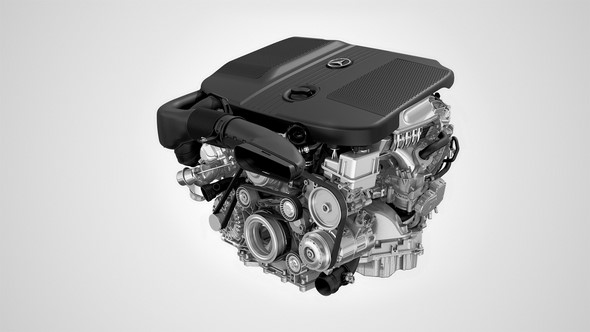
The Saloon soon also proved its sporty qualities. After the market launch of the new model series with the models 190 and 190 E, the new top-of-the-line model 190 2.3-16 followed in 1983. Before its premiere the new model had already set several long-distance world records with average speeds of almost 250 km/h in Nardò (Southern Italy).
Entrance of the first C-Class: the 202 model series (1993 to 2000)
From May 1993 Mercedes-Benz further expanded on the strengths of the W 201 in the 202 model series – the first C-Class to actually bear this name: even though the new Saloon was hardly larger than the “Baby Benz”, the designers and engineers managed to increase the interior space considerably and further enhanced passive and active safety as well.
This was accompanied by innovations such as the first turbodiesel engine with common-rail direct injection from Mercedes-Benz (launch in 1997 in the C 220 CDI).
The 202 model series was also a clear statement of the Stuttgart-based brand for the role of the C-Class as a comprehensive vehicle family: in addition to the Saloon (W 202), an Estate model (S 202) became available for the first time starting in March 1996.
It had an impressive load compartment volume of up to 1510 litres. There were also the design and equipment lines CLASSIC, ESPRIT, ELEGANCE and SPORT as well as a particularly dynamic AMG equipment package with sports suspension, AMG light-alloy wheels and AMG design elements.
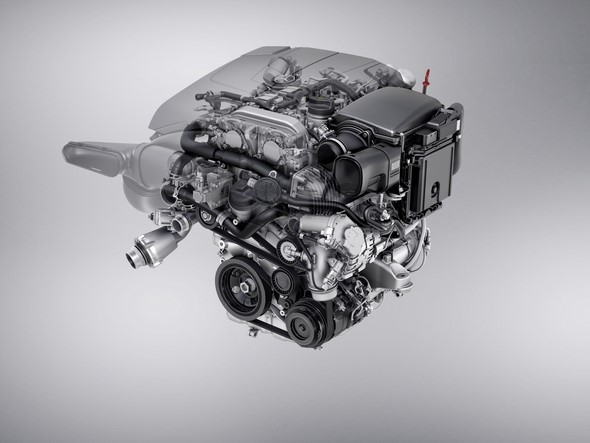
Innovative diversity also characterised the engine range, which included four and six-cylinder engines and even a V8 engine in the top-of-the-line AMG models. The pinnacle of this evolution was the C 55 AMG with a power output of 255 kW (347 hp) in 1998.
Sporty technology leader: the 203 model series (2000 to 2007)
The international success of the C-Class as a compact premium automobile was continued by the 203 model series starting in 2000.
This third generation of the model series family not only underscored its role as a technology leader in its market segment, but with it Mercedes-Benz also further expanded the diversity of the C-Class.
In the autumn of 2000 the youthful and fresh Sports Coupé celebrated its premiere as new body style. The two-door car presented a particularly dynamic interpretation of the four-headlamp look of the 203 model series, joined by powerful lines of the body with a distinctive rear end.
On the inside the Coupé was dominated by a cockpit with sporty design and aluminium trim. The Estate model (S 203) joined the Saloon and the Sports Coupé in 2001 as the third body style.
The lifestyle vehicle with high utility continued the success of its predecessor (S 202).
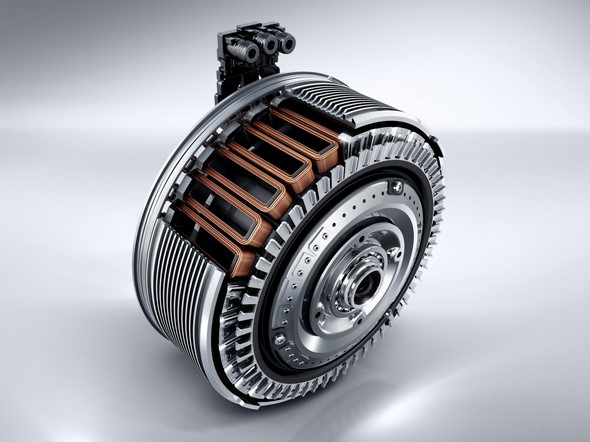
The 203 model series offered more than 20 technical innovations previously unavailable in this market segment. They included safety, comfort and dynamic handling systems.
At the same time the engineers further lowered the fuel consumption of the C-Class with new engines and aerodynamic optimisations. The 203 model series moreover offered highly dynamic vehicle handling.
Brilliant with two fronts: the 204 model series (since 2007)
The C-Class of the 204 model series was the first to launch with two different vehicle fronts. While the ELEGANCE and CLASSIC design and equipment lines sported the classic Mercedes radiator grille, the AVANTGARDE line with the Mercedes star positioned in the radiator grille had a sportier appearance.
This design was even more focused on the values of the individual lines and reflected a diverse overall concept.
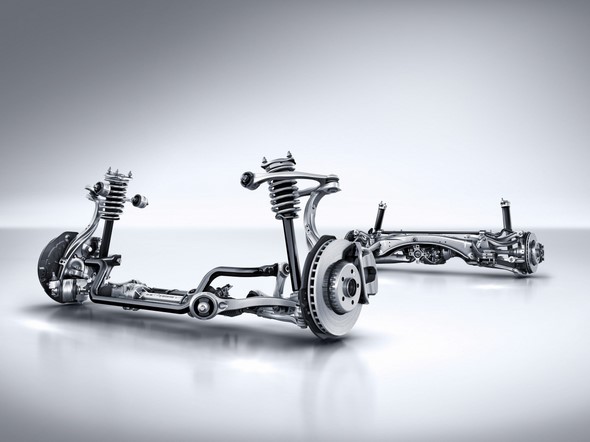
The fourth generation of the C-Class was particularly successful in also meeting the expectations of very different target groups. The merits of the 204 model series included sportiness and elegance as well as high efficiency.
Modern engines, lightweight construction and optimised aerodynamics ensured that the 204 model series consumed up to 17 percent less fuel than the predecessor model series.
With the facelift in 2011 the C-Class Coupé (C 204) joined the Saloon and the Estate, taking the place of the Sports Coupé.
Long history of innovation of compact vehicles
Since the debut of the W 201 in 1982 the Mercedes-Benz C-Class again and again set benchmarks for innovative technology, pioneering design and compact sportiness in the premium medium-size category.
Starting in 2014, the 205 model series will lead these strengths further into the future.
The roots of this success story go back much farther than 1982 however. As far back as the 1920s, 1930s and the 1950s there were visionary designs at Mercedes-Benz for more compact vehicles below the respective models and model series of the upper medium-size segment.
In the 1970s the time had finally come to bring these visionary ideas to series maturity. The decision to develop what would become the W 201 was made in January 1974. That was the birth of today’s C-Class.
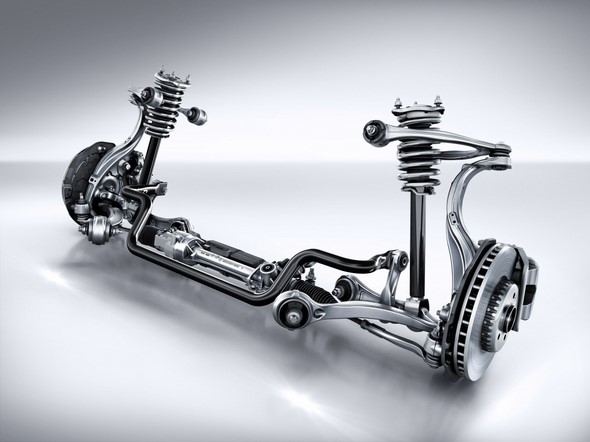
The highlights of the W 201 and the C-Class
The Mercedes-Benz C-Class and its direct predecessor, the W 201, again and again set benchmarks with innovative technology.
In 1982 Mercedes-Benz managed to incorporate the classic values of the brand such as safety, comfort and sustainability in a more compact vehicle.
In this way the “Baby Benz” opened up the segment of premium mid-size category for the Stuttgart-based brand on a level of excellence.
Since the birth of the compact category the C‑Class has evolved continuously and has become more and more diverse in the process.
201 model series (1982 to 1993)
- Multi-link rear axle with five independent links for highly balanced and safe handling
- Shock absorber strut independent front suspension with anti-dive geometry, located by individual wishbones
- Optimised forked-member structure of the front end for a higher level of passive safety, in particular in a frontal collision
- Efficiency and aerodynamics (Cd=0.33)
- Anti-lock braking system (ABS) available from 1982, standard initially for the sportier 190 E 2.3-16 model (from late 1984)
- Airbag available from 1982, standard from 1992
- Catalytic converter for petrol engines from 1985
- Oxidation catalyst for diesel engines available from 1990
- Four-valve technology in large-scale production (launch model: 190 E 2.3-16)
- Encapsulated diesel engine with exemplary soundproofing (“whisper diesel”)
- Records over 50,000 kilometres, 25,000 miles and 25,000 kilometres as well as nine class records in Nardò with the 190 E 2.3-16 in 1983
- 190 E 2.5-16 EVO: homologation vehicle for German Touring Car Championship (DTM), 1989
202 model series (1993 to 2001)
- A total of four design and equipment lines: Esprit, Elegance and Sport expand the classic equipment line as additional lines
- C 220 CDI, 1998: first diesel-powered passenger car with common-rail direct injection
- Supercharging of petrol engines with Roots compressor
- Four-valve technology and standard-fit oxidation catalyst for diesel engines
- C 36 AMG: first AMG model of the C-Class, 1993
- Estate model (S 202) starts body style diversity in the C-Class in 1996
- Electronic Stability Program (ESP®): 1997 as optional extra for V6 models, standard equipment from 1999
- Keyless drive authorisation system ELCODE, standard from 1997
- Optional car telephone integrated into armrest
- 1997: standard specification with safety innovations such as front sidebags, front performance belt tensioners with belt-force limiters, electronic brake assist
- First V8 engine in the C-Class in the C 43 AMG, 1997
- Active Service System ASSYST (from 1997) enables need-based engine maintenance with average maintenance intervals of 22,500 instead of 15,000 kilometres
- Automatic door locking from 15 km/h (starting in 1997)
- Winning vehicle in the German Touring Car Championship (DTM) in 1994 (Klaus Ludwig) and 1995 (Bernd Schneider)
- Official Safety Car of Formula 1 (C 36 AMG, 1996)
- Official Medical Car of Formula 1 (C 36 AMG Estate in 1996 and 1997; C 55 AMG Estate from 1998 to 2000)
203 model series (2000 to 2007)
- Front module with crash boxes of high-strength steel for yet further improved passive safety
- New three-link front axle with McPherson struts ensures more precise handling
- Optional 7G-TRONIC seven-speed automatic transmission (from 2005)
- Premiere for COMAND Online in the C-Class
- Sports Coupé as the third body style of the C-Class
- Panoramic sliding sunroof in the Sports Coupé with continuous glass look
- The technical standard of the model series set benchmarks as the technology leader for the market segment with more than 20 innovations such as windowbags, adaptive airbags for driver and front passenger, Headlamp Assist, multifunction steering wheel. central display and fibre optic cables
- C 32 AMG (2001 to 2004) and C 55 AMG (2004 to 2007) as top-of-the-line models
- 4MATIC in the C-Class (from 2002 available in the V6 models with petrol engine)
- Sensor-controlled THERMOTRONIC luxury automatic climate control
- LINGUATRONIC voice-operated control system optionally operates the telephone, navigation system, radio and CD player
- Winning vehicle in the German Touring Car Masters (DTM) 2005 (Gary Paffett) and 2006 (Bernd Schneider)
- Official Medical Car of Formula 1 (C 32 AMG Estate 2001 to 2003; C 55 AMG Estate 2004 to 2007)
- C 55 AMG Estate as Safety Car of the DTM (2004 and 2005)
- Two different fronts for even more diversity, Mercedes star centred in the radiator grille for the sporty AVANTGARDE design and equipment line
- DISTRONIC PLUS proximity control
- Intelligent Light System with bi-xenon headlamps for five different lighting functions
- PRE-SAFE® system with preventive occupant protection measures
- AGILITY CONTROL package with situation-dependent damper control
- New generation of diesel engines in the C 250 BlueEFFICIENCY
- New Coupé (C 204) as the most exclusive form of the C-Class from 2011
- Extensive package of assistance system from 2011, including Active Lane Keeping Assist, Active Blind Spot Assist, ATTENTION ASSIST, DISTRONIC PLUS, Parking guidance with PARKTRONIC, PRE-SAFE® Brake, Lane Keeping Assist and Blind Spot Assist
- Aerodynamic drag of Cd=0.26 sets benchmarks for the market segment
- Lightweight construction: aluminium bonnets, 2011
- Most powerful C-Class: C 63 AMG Coupé Black Series with 380 kW (517 hp)
- Winning vehicle in the German Touring Car Masters (DTM) 2010 (Paul di Resta)
- C 63 AMG Safety Car of the DTM, from 2012 C 63 AMG Coupé Black Series
- Official Medical Car of Formula 1 (C 63 AMG Estate, since 2008)
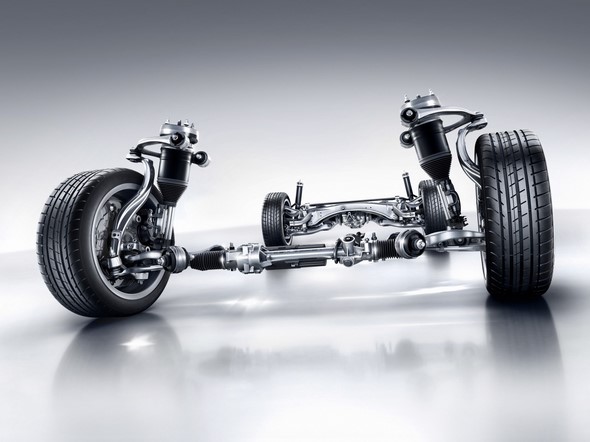
The new Mercedes-Benz C-Class, which launches in 2014, continues the successful tradition of the compact category from Mercedes-Benz.
Among the benefits of the all-new 205 model series are the lightest body shell in its market segment as well as extensive innovations in the areas of safety, suspension and comfort.

